Welcome to my lens guide for the Sony a6400 mirrorless camera.
The Sony a6400 has an APS-C sized sensor and uses the Sony E-mount system. This means that it’s compatible with any of Sony’s E-mount lenses or even third-party E-mount lenses like Sigma or Rokinon.
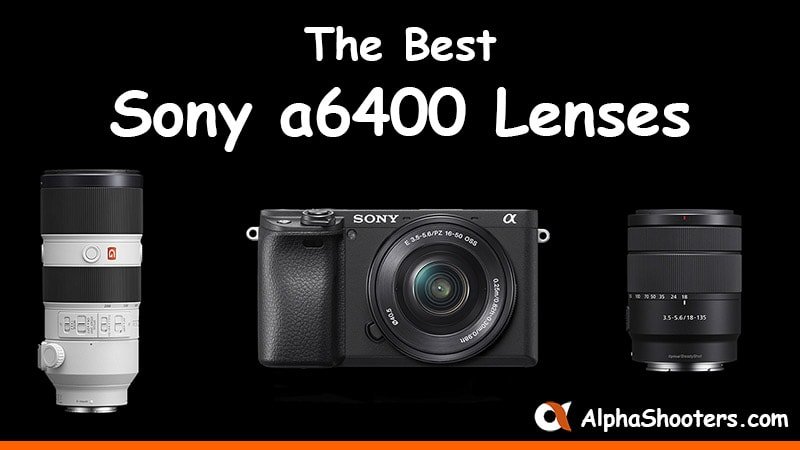
Although this guide is specifically for the Sony a6400, these lenses are also supported with all of Sony’s E-mount mirrorless APS-C cameras and also their full-frame a7 / a9 mirrorless cameras when used in APS-C mode.
Sony a6400 Forum & Facebook Group
If you are looking for further help and advice on the a6400 or would simply like to share your photos and videos, then please head over to our friendly Sony a6400 Forum. If you prefer Facebook then I also run the Sony a6400 Shooters Group.
Quick Navigation
- Top 10 Lenses
- All-in-One Lenses
- Wide-Angle Lenses
- Portrait Lenses
- Macro Lenses
- Telephoto Lenses
- Pancake Lenses
- Budget Lenses
- FAQ’s
- Lens Firmware Updates
- Helpful Resources
**Please Note: Unless otherwise mentioned no post processing has been applied to the image samples in this guide except for cropping. Full resolution SOOC JPEG images are available to download. RAW files are also available but password protected to help keep my hosting costs sensible. However, I do provide the username/password to all members of our community forum. All images are copyright protected and may be used for personal use only.
Top 10 Sony a6400 Lenses
Here are my top 10 recommended lenses for the Sony a6400 mirrorless camera.
- Sony E 10-18mm F4 OSS
- Rokinon / Samyang 12mm f/2.0 NCS CS
- Sigma 16mm f/1.4 DC DN
- Sony E PZ 18-105mm F4 G OSS
- Sony E 18-135mm F3.5-5.6 OSS
- Sony E 16-55mm F2.8 G
- Sigma 30mm f/1.4 DC DN
- Sigma 56mm f/1.4 DC DN
- Sony FE 85mm F1.8
- Sony FE 90mm F2.8 Macro G OSS
All-in-One Lenses
An all-in-one lens typically covers a wide focal range and allows you to shoot anything from a moderate wide-angle landscape scene, a portrait shot or even a small telephoto shot. All-in-one lenses make great walk-around and travel lenses for when you want to keep your gear as light as possible.
Sony E 16-55mm F2.8 G (SEL1655G)
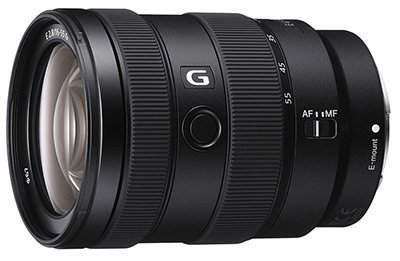
The Sony E 16-55mm F2.8 G lens is a high quality standard zoom lens with a fast f/2.8 aperture for low light shooting and creamy bokeh.
The lens body is well built and weighs only 494g (17.5 oz). The lens is weather sealed to help prevent dust and moisture ingress and both the zoom and focus rings are silky smooth. There is no focus breathing when you zoom in and out and the autofocus motor is both fast and quiet making it a great lens for video work.
Wide-open at f/2.8 and 16mm the center of the frame is very sharp as are the corners, things get a little sharper at f/4 and f/5.6 but diffraction kicks in around f/16 and you’ll start to lose sharpness. At 55mm the center of the frame is razor sharp but the corners are just a little softer, step down to f/4 and now even the corners are sharp. Diffraction will kick in around f/11 at 55mm.
If you shoot RAW then you’ll notice some barrel distortion at 16mm when shooting at f/2.8 but this is gone by around 30mm. If you shoot in JPEG then in-camera corrections take care of the distortion for you.
Flaring is well controlled but there is a little color fringing when shooting wide-open, but this clears up at around f/5.6.
Sadly Sony decided not to include stabilization in this lens, so it’s definitely beneficial to pair it with a camera like the a6600 which includes in-body-stabilization (IBIS), especially for shooting videos or at night. That said, providing you are using a fast enough shutter speed this lens will still be fantastic on the a6400 which doesn’t have IBIS. Of course, you can also use a gimbal if you want really smooth video.
Overall this is an excellent lens, although it should be because it’s also one of Sony’s most expensive APS-C lenses.
Pros: Well built, fast f/2.8 aperture, bokeh, razor sharp, flare control, quiet autofocus motor
Cons: No stabilization
Recommended Reviews: Christopher Frost (YouTube) | Arthur R (YouTube) | Jason Vong (YouTube)
Sample Photos: Sony Gallery | Flickr
Format: APS-C
Lens Construction: 12 groups, 17 elements
Angle of View: 83°-29°
Aperture Blades: 9 rounded
Minimum Aperture: f/22
Maximum Aperture: f/2.8
Minimum Focusing Distance: 1.09 ft (0.33 m)
Maximum Magnification Ratio: 0.66
Auto Focus: Yes
Stabilization: No
Filter Thread Size: 67mm
Length: 100mm
Diameter: 73mm
Weight: 494g / 17.5 oz
Sony E 18-135mm F3.5-5.6 OSS (SEL18135)
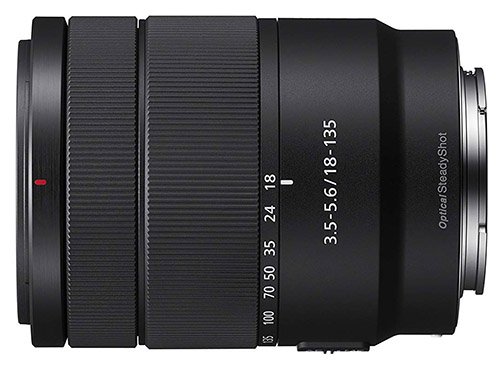
The Sony E 18-135mm F3.5-5.6 OSS is an APS-C lens that does everything really well. It’s small and lightweight and is definitely my own personal favourite travel lens for when I want to travel as light as possible. It covers a wide focal range from 18mm all the way up to 135mm and has a variable aperture of f/3.5 up to f/5.6.
Central sharpness at 18mm is very good but does improve from f/5.6 all the way up to f/11. At f/16 diffraction kicks in and things start to get just a little softer. At 35mm sharpness is excellent from f/3.5 up to f/11 then starts to drop at f/16. At 70mm and 135mm central sharpness is excellent from f/5.6 to f/11, but starts to drop at f/16. The edges are a little soft when using the longer focal lengths, but the center always remains sharp.
There is strong vignetting at 18mm if you are shooting in raw or with in-camera corrections turned off, this doesn’t improve if you step down either. In order to keep this lens compact Sony are relying more heavily on in-camera corrections.
CA (Chromatic Aberration) centrally at 18mm is very well controlled, however the edges do show signs of fringing. This improves up to 70mm, but then at 135mm things become worse. Fortunately in-camera corrections take care of this, so if you are shooting in JPEG you don’t need to worry about it. Flare control is excellent and the bokeh is very smooth.
The Sony E 18-135mm F3.5-5.6 OSS lens also includes the inbuilt OSS (Optical Steady Shot) system which helps to stabilize camera shake on cameras that do not have IBIS built-in (like the Sony a6400). The autofocus motor is both fast and silent, and the lens feels well built. Sadly it is not weather sealed, so you need to be a little more careful with this lens when the heavens open.
I own this lens myself and have no regrets buying it. If you want an all-in-one travel lens that can do everything well and not weigh you down, then this is it. Here are just a couple of shots I’ve taken with it on my Sony a6400.
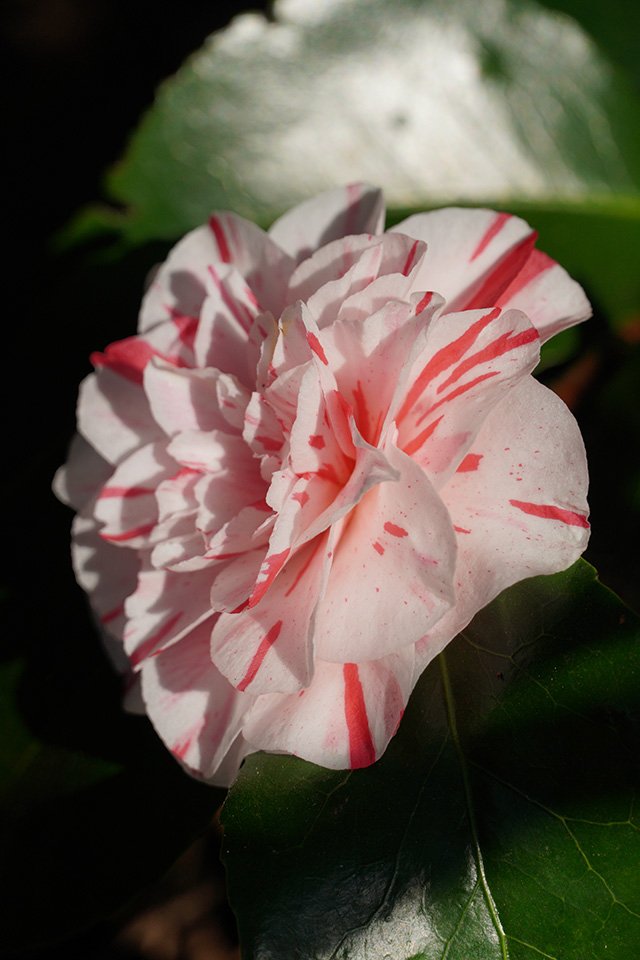
Sony E 18-135mm (Shot on a6400) @ 125mm | 1/1000 | f/6.3 | ISO 200 | ** Full Resolution SOOC Download: JPEG | RAW
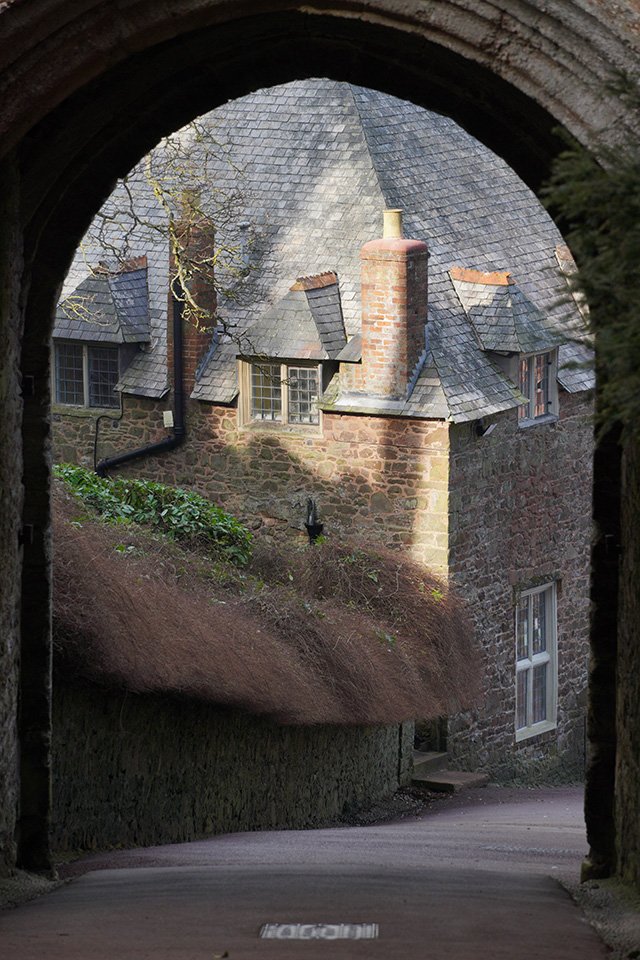
Sony E 18-135mm (Shot on a6400) @ 120mm | 1/200 | f/8 | ISO 200 | ** Full Resolution SOOC Download: JPEG | RAW
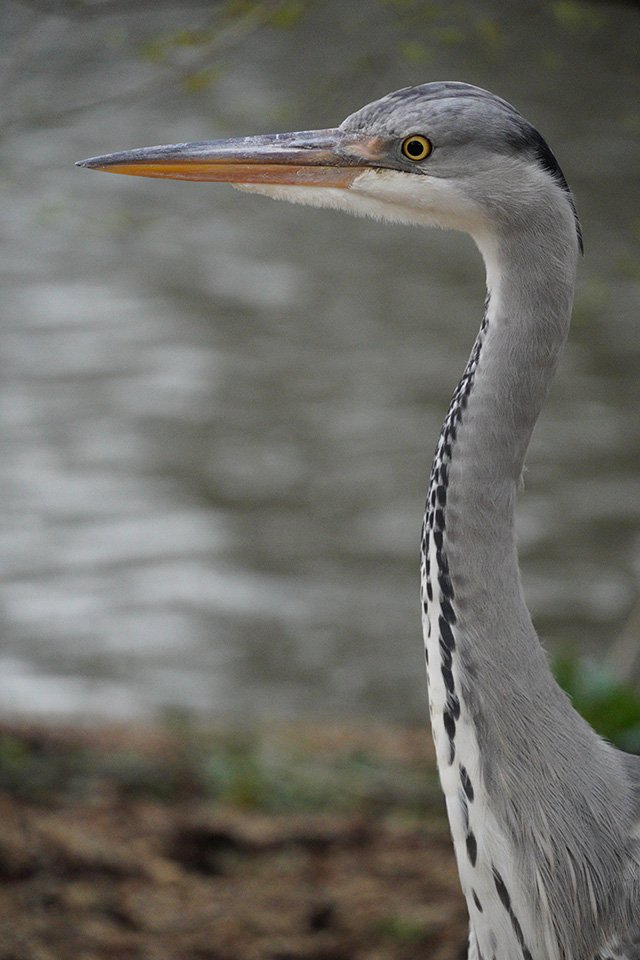
Sony E 18-135mm (Shot on a6400) @ 135mm | 1/1000 | f/5.6 | ISO 3200 | ** Full Resolution SOOC Download: JPEG | RAW
Pros: Lightweight, well built, bokeh, central sharpness, fast AF
Cons: No weather sealing, vignetting at 18mm, poor edge sharpness at 135mm
Recommended Reviews: Technology Mafia (YouTube) | SonyAlphaLab (YouTube) | Christopher Burress (YouTube) | ePhonezine
Sample Photos: My Sample Photos | Flickr
Minimum Focusing Distance: 0.45 m (1.48 ft)
Minimum Aperture: f/22-36
Maximum Aperture: f/3.5-5.6
Aperture Blades: 7
Auto Focus: Yes
Stabilization: Yes
Filter Thread Size: 55mm
Length: 88mm (3-1/2 in.)
Diameter: 67.2mm (2-3/4 in.)
Weight: 325 g (11.5 oz.)
Sony E PZ 18-105mm F4 G OSS (SELP18105G)
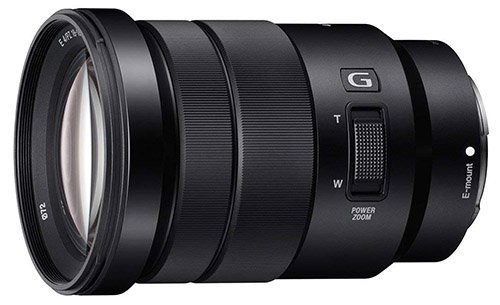
The Sony E PZ 18-105mm F4 G OSS lens is possibly one of the most popular short zoom APS-C lens that Sony makes. The 18-105 features a constant aperture of f/4 and a motorized internal zoom so the lens body itself does not extend, this makes balancing it on a gimbal for video work so much easier. Sony label this as a G lens, so both the build and optical quality are a step above their non G lenses. At 427g this lens is a good 100g heavier than the 18-135mm and it’s also longer and wider too.
The lens has optical image stabilization built in and the autofocus is both fast and accurate. The motorized zoom is controlled by a rocker switch on the lens which is great for video shooters but for stills I’d much rather have a non-motorized zoom.
At 18mm and the maximum aperture of f/4 central frame sharpness is excellent and the corners are just a little softer. Stopping down to f/5.6 improves the central sharpness even further and the corners are now also nice and sharp. At 45mm sharpness is even better and at 105mm sharpness is still excellent. Sadly, at 105mm edge sharpness does take a turn for the worse.
At the edges of the frame you will see some chromatic aberrations are prevalent towards the edges of the frame and there is also some vignetting at 18mm and f/4. Step-down to f/5.6 and the vignetting is gone. Distortion unfortunately it not so well controlled with both barrel and pincushion distortion visible. In-camera corrections will take care of this distortion when shooting in JPEG mode, but central sharpness can suffer as a result. Flare control is very good even when shooting directly into bright light sources.
I own this lens myself but since purchasing the 18-135mm lens it has just bene collecting dust. The 18-135mm is smaller, lighter, sharper in the center, and despite the variable aperture is definitely my preferred lens to take with me when I’m travelling light. However, video shooters might prefer the constant f/4 aperture, motorized zoom, and fixed length over the variable aperture and manual zoom of the 18-135mm, and the edge sharpness will probably be of less concern.
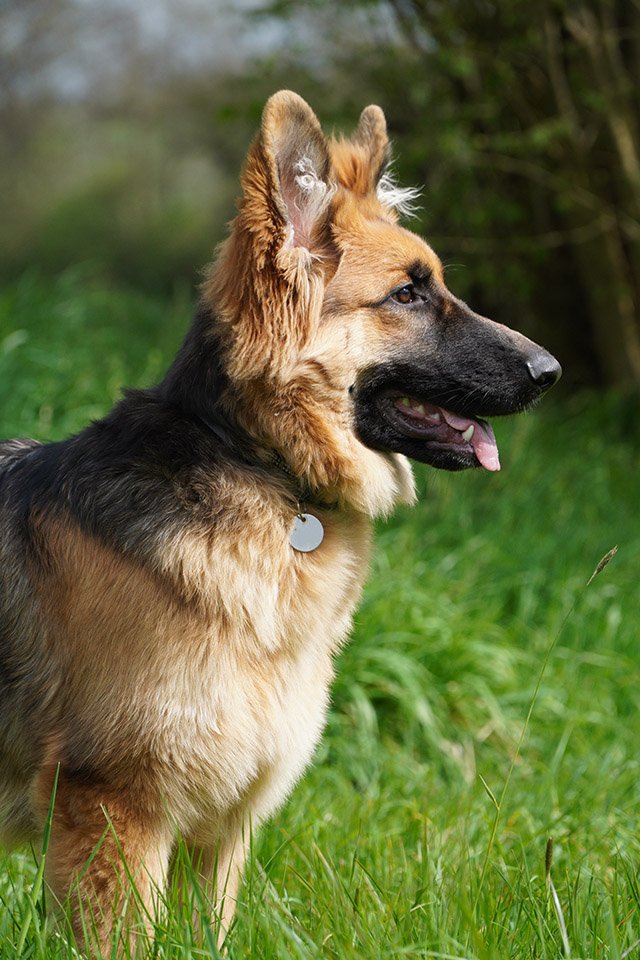
Sony E PZ 18-105mm (Shot on a6400) @ 105mm | 1/1250 | f/4.5 | ISO 250 | Full Resolution SOOC Download: JPEG
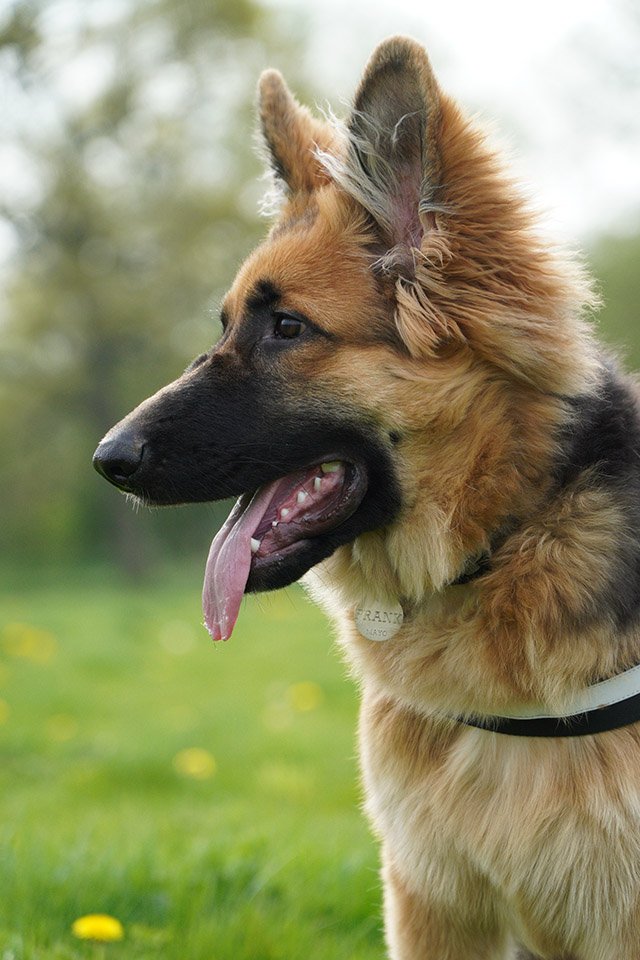
Sony E PZ 18-105mm (Shot on a6400) @ 105mm | 1/1600 | f/4 | ISO 500 | ** Full Resolution SOOC Download: JPEG | RAW
Pros: Build quality, center sharpness, image stabilization, constant aperture
Cons: Edge sharpness at f/4 not great, CA, distortion at 105mm
Recommended Reviews: Jordan Steele | Christopher Frost (YouTube)
Sample Photos: Flickr
Minimum Focusing Distance: 0.45 (Wide)-0.95m (Tele) (1.48 (Wide)-3.12ft (Tele))
Minimum Aperture: f/22
Maximum Aperture: f/4
Aperture Blades: 7
Auto Focus: Yes
Stabilization: Yes
Filter Thread Size: 72mm
Length: 110mm (4-3/8in.)
Diameter: 78mm (3-1/8 in.)
Weight: 427g (15.1oz.)
Sony E 18–200mm F3.5–6.3 OSS LE (SEL18200LE)
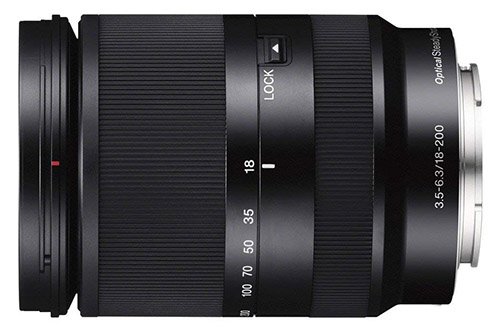
If the Sony E 18-135mm lens is too short at the long-end of the zoom range for you, then the Sony E 18–200mm F3.5–6.3 OSS LE lens might be worth investing in. This APS-C lens covers a very useful focal length from 18mm all the way up to 200mm with a variable aperture of f/3.5 to f/6.3.
The lens is well built and has optical image stabilization (OSS) built in that helps to limit camera shake allowing you to shoot handheld at much lower shutters speeds. The autofocus is quick, accurate and quiet.
The Sony E 18-200mm f/3.5-6.3 EL offers very good results for sharpness between 50mm and 100mm, at 200mm sharpness isn’t as great, but will still be acceptable to most. At its widest angle of 18mm the lens produces reasonably sharp images even at its widest aperture of f/3.5. Stopping down doesn’t offer any improvement for sharpness and diffraction takes hold at f/8-f/11, but there’s no noticeable sharpness drop-off until f/16.
The lens does show some signs of chromatic aberration at the wide and tele-ends, but the a6400 will apply corrections for CA when shooting in JPEG mode. Vignetting is visible at 18mm and f/3.5, but stop down to f/5.6 and you won’t see it. At 200mm vignetting at f/6.3 is again visible, but stop down to f/8 and it’s gone.
Distortion can be found throughout the entire focal length but the a6400 will apply in-camera correction to fix this for you, at least if you are shooting in JPEG mode. The SEL18200LE handles flare pretty well even when shooting directly into bright sunlight.
Pros: Wide focal range, build quality, central sharpness, flare control
Cons: Vignetting wide-open, distortion, price
Recommended Reviews: James Tan | John Sison (YouTube)
Sample Photos: Flickr
Minimum Focusing Distance: 0.5m (1.64ft)
Minimum Aperture: f/22-40
Maximum Aperture: f/3.5-6.3
Aperture Blades: 7
Auto Focus: Yes
Stabilization: Yes
Filter Thread Size: 62mm
Length: 97.1mm (3-7/8 in.)
Diameter: 68mm (2-3/4 in.)
Weight: 460g (16.3oz.)
Wide-Angle Lenses
A wide-angle lens allows more of the scene to be included in the frame. Both wide-angle and ultra-wide-angle lenses are popular choices with landscape, architectural and interior photographers.
Sony E 10-18mm F4 OSS (SEL1018) APS-C Lens
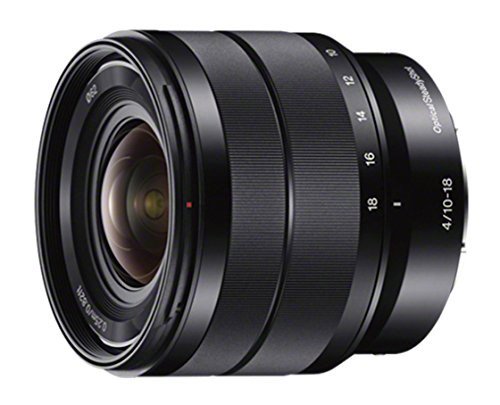
The Sony E 10-18mm F4 OSS is an APS-C lens and also the widest that Sony offers with a focal range of between 10-18mm. With a maximum constant aperture of f/4, autofocus and optical image stabilization all packed into a high quality metal housing, this is really a pretty nice lens and also one that I own myself.
At 10mm the lens is already sharp at f/4 in the center of the frame, but things do get a little softer towards the edge. However, stop down to f/5.6 and the edges soon become nice and sharp and at f/8 the sharpness is extremely good across the frame. For 9/10 of my landscape shots I’m typically using this lens at f/8, so don’t worry about the softer corners when wide-open at f/4. At 14-18mm sharpness drops off a little at f/4, but stopping down to f/8 soon sharpens things up again.
Chromatic aberrations are reasonably well controlled but some purple fringing is visible in high contrast shots. However, with lens corrections turned on in the a6400 this will always be corrected with JPEG images and if you shoot raw then you can easily fix this in post.
Wide-angle lenses often suffer from vignetting in the corners and the 10-18mm is no different. At 10mm and f/4 vignetting is apparent and it’s not even gone completely at f/11. Thankfully in-camera corrections also take care of this for JPEG images. There is only a small amount of distortion visible but again this will be corrected in-camera for JPEGS.
At only 225g this is a very light lens and is often my first choice when I’m travelling light or hiking in the mountains.
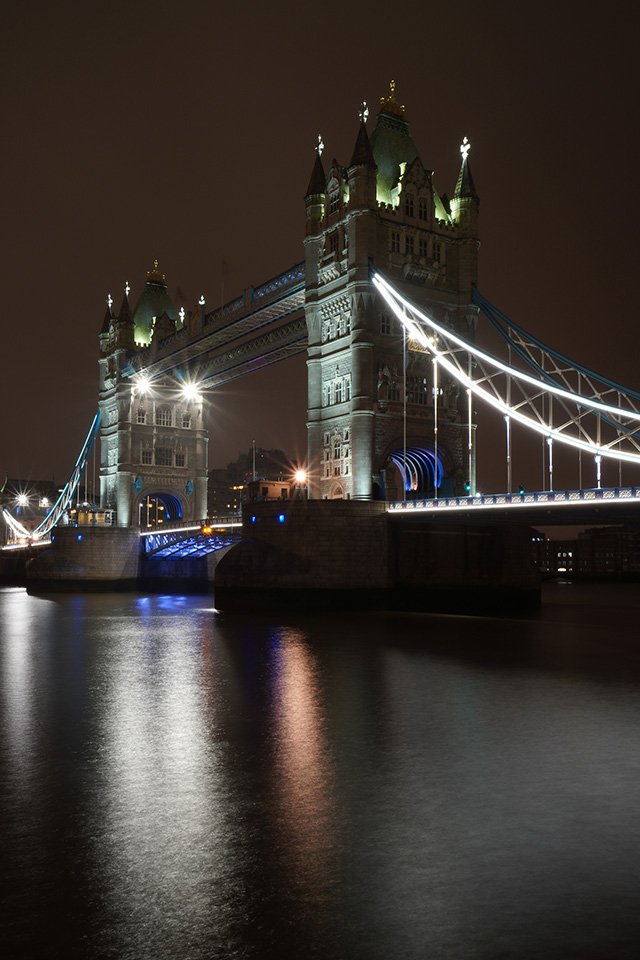
Sony E 10-18mm (Shot on a6400) @ 18mm | 30sec| f/22 | ISO 100 | Cropped | ** Full Resolution SOOC Download: JPEG | RAW
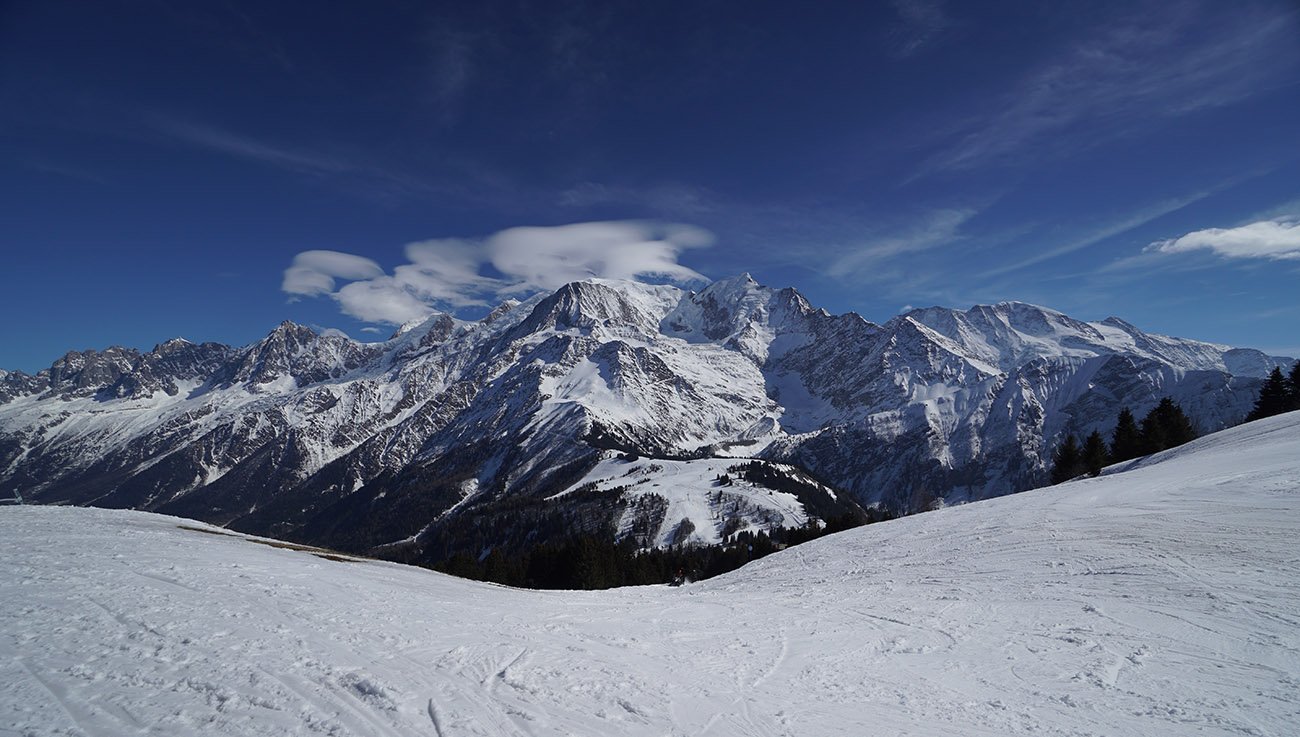
Below is a shot of Mont Blanc that I took with the 10-18mm on my Sony a6500, I only admired this mountain from afar!
Sony E 10-18mm (Shot on a6500) @ 10mm | 1/400 | f/7.1 | ISO 100 | Handheld | ** Full Resolution SOOC Download: JPEG | RAW
Pros: Build quality, low weight, sharpness, distortion, quiet AF motor
Cons: Vignetting, expensive
Recommended Reviews: Drew Robinson | John Sison (YouTube) | Stuck in Customs | SonyAlphaLab
Sample Photos: Flickr
Minimum Focusing Distance: 0.25m (0.82ft)
Minimum Aperture: f/22
Maximum Aperture: f/4
Aperture Blades: 7
Auto Focus: Yes
Stabilization: Yes
Filter Thread Size: 62mm
Length: 63.5mm (2-1/2 in.)
Diameter: 70.0mm (2-7/8 in.)
Weight: 225g (8oz.)
Laowa 9mm f/2.8 Zero-D
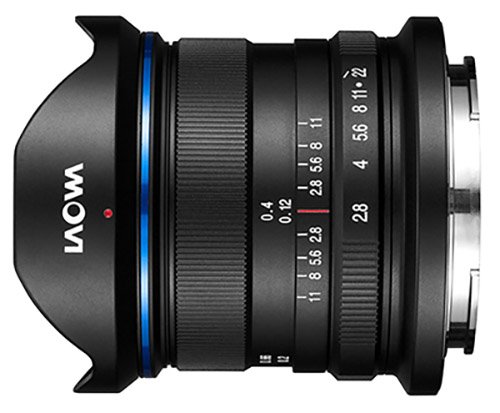
The Laowa 9mm f/2.8 Zero-D is the widest wide-angle lens that you can currently buy for Sony APS-C E-mount cameras like the a6400. It is manual focus only, but if don’t mind this then this lens is definitely a great one to have in your gear bag.
Wide-open at f/2.8 central sharpness is excellent, and it becomes even better at f/4 and f/5.6. Edge sharpness isn’t quite so good wide-open, but it’s very good when you hit f/5.6 through to f/11. Diffraction will start to kick in if you stop down past f/11. CA (Chromatic Aberration) is very well controlled. Vignetting wide-open at f/2.8 is very noticeable, and it remains even if you step-down to f/11.
Despite the Zero-D in the name which stands for “Zero Distortion”, there is very minimal distortion but it’s really nothing to worry about and can easily be corrected in post. Flare control could be better and you will get some flare when pointing this lens towards strong light sources, even with the lens hood on.
The Laowa manages coma very well making the Laowa 9mm an option for astrophotographers, although the vignetting could be cause for concern.
The Laowa 9mm f/2.8 Zero-D is very well built and weighs in at only 215g, so you will barely notice this lens on your Sony a6400. If money were no object I’d order one today.
Pros: Very sharp, low CA, low distortion, compact
Cons: Manual focus only, flare control, vignetting, price
Recommended Reviews: Christopher Frost (YouTube) | Technology Mafia (YouTube) | ePhotoZine
Sample Photos: FlickR
Minimum Focusing Distance: 0.12m (0.39ft)
Minimum Aperture: f/22
Maximum Aperture: f/2.8
Aperture Blades: 7
Auto Focus: No, manual focus only
Stabilization: No.
Filter Thread Size: 49mm
Length: 53mm (2.1 in.)
Diameter: 60mm (2.36 in.)
Weight: 215g (7.58oz.)
Price Check & Buyer Reviews for Laowa 9mm f/2.8 Zero-D
At: Amazon | B&H Photo | Venus Lens
Rokinon / Samyang 12mm f/2.0 NCS CS
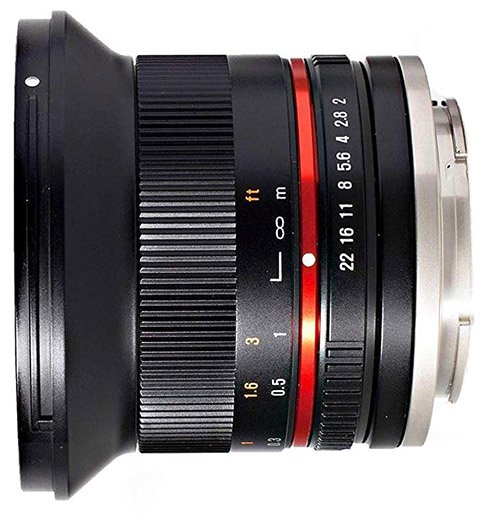
The Rokinon 12mm f/2.0 NCS CS as it’s known in the US, or the Samyang 12mm f/2.0 NCS CS as it’s known in Europe are both identical APS-C lenses from the same company, but for their own branding reasons use the name Rokinon in the US and Samyang in Europe. I’m just going to call it Rokinon here to make life easier for me. So now that’s cleared up is the lens any good?
Optically, the Rokinon 12mm f/2.0 NCS CS is a very good lens. It’s sharp wide-open at f/2 in the center of the frame and the edges just drop off a little. Sharpness improves even more at f/2.8 and f/4 and the edges are nice and sharp also by f5/6. There is mild barrel distortion and some vignetting wide-open at f/2 but this improves by f/4.
For astrophotographers this lens has excellent coma performance, combined with its fast f/2 aperture and an ultra-wide field of view make it a superb lens for shooting the night sky.
The build quality of this lens is excellent and it feels solid, despite weighing only 245g. The only downside to this lens is that both the aperture control and focusing are completely manual, as the lens has no electronic contacts with the camera.
If you don’t mind manually focusing then for the price this lens is really hard if not impossible to beat right now, that’s providing that you are happy with the 12mm focal length. If you need wider, then your best bet is the Sony E 10-18mm F4 or the Laowa 9mm f/2.8 Zero-D.
Pros: Sharpness, build quality, low CA, low coma, price
Cons: Manual focus only
Recommended Reviews: Ian Norman | Jordan Steele | Drew Robinson | Technology Mafia (Youtube)
Sample Photos: Flickr
Minimum Focusing Distance: 0.2m (0.66ft)
Minimum Aperture: f/22
Maximum Aperture: f/2
Aperture Blades: 6
Auto Focus: No, manual focus only
Stabilization: No
Filter Thread Size: 67mm
Length: 59mm (2.32 in.)
Diameter: 72.5mm (2.85 in.)
Weight: 245g (8.64oz.)
Sigma 16mm f/1.4 DC DN
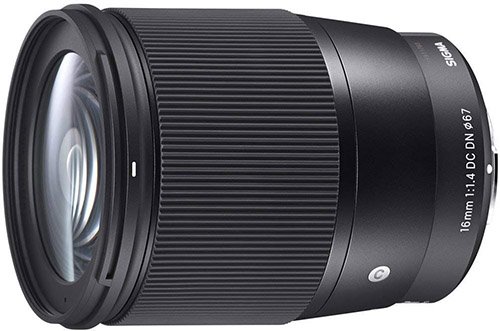
If you are looking for one of the sharpest wide-angle APS-C lenses with autofocus, then the Sigma 16mm f/1.4 DC DN is certainly a lens that you will want to take a closer look at.
With a maximum aperture of f/1.4 this is a very fast lens. Central sharpness is very good at f/1.4 and f/2, and it becomes even sharper at f/2.8 through to f/8. Diffraction does start to kick in from around f/11 but sharpness still remains good.
There are signs of CA (Chromatic Aberration) both centrally and at the edges of the frame, but this is very low and can easily be corrected in-camera if you are shooting JPEGS and in post if you are shooting raw. Barrel distortion is practically nonexistent and certainly nothing to worry about.
Flare resistance is extremely good and even when shooting directly into the sun it’s very difficult to induce any flare at all. The nine bladed aperture also produces very pleasing sunstars when you step the aperture down.
The focus ring is buttery smooth and the lens itself is well built and weather sealed, the only real downside to this lens is that the AF motor is not the quietest.
For astrophotography shooters this lens does unfortunately exhibit some coma. Stars are nice and round in the center of the frame, but closer to the edges they do start to stretch a little. But that certainly doesn’t stop this being one of the best APS-C lenses for astrophotography, here’s a YouTube Review worth watching if you shoot astro, and also a Sigma 16mm F1.4 vs Rokinon 12mm F2.0 Comparison for astro.
Pros: Sharpness, price, low CA, build quality, flare resistance
Cons: AF motor noise
Recommended Reviews: Dustin Abbott | Technology Mafia (YouTube)
Sample Photos: Flickr
Minimum Focusing Distance: 0.25m (2.07ft)
Minimum Aperture: f/16
Maximum Aperture: f/1.4
Aperture Blades: 9
Auto Focus: Yes
Stabilization: No
Filter Thread Size: 67mm
Length: 92.3mm (3.6 in.)
Diameter: 72.2mm (2.8 in.)
Weight: 405g (14.3oz)
Portrait Lenses
Portrait lenses are often very subjective, as you can more or less use any lens that you like to shoot portraits with. Ultimately the decision is likely to come down to your own personal style of photography and the perspective that you are looking for.
Sony E 35mm F1.8 OSS (SEL35F18)
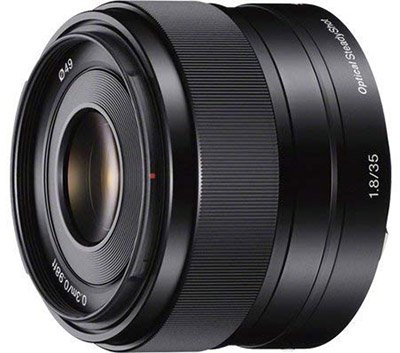
With a focal length of 35mm on an APS-C camera like the Sony a6400, the Sony E 35mm F1.8 OSS lens offers an equivalent focal length on a full-frame camera of around 52mm. For portrait photography this is a little wider than the often preferred 85mm focal length for portrait shooters, but it’s a still works a treat and also allows you to include more of the environment in your image.
At f/1.8 sharpness in the center of the frame is very good, the edges are a little softer and you will need to stop down to around f/4 to sharpen these up. Chromatic aberrations are very well controlled, but there is a small amount of purple fringing when shooting high contrast subjects wide-open, stepping down corrects this as does turning on in-camera corrections if you are shooting JPEG. There is a little vignetting wide-open at f/1.8, but stepping down to f//4 soon clears this up.
There is little in the way or distortion to worry about and the coating on the lens does a very good job of resisting flare. The OSS does a good job of stabilizing the lens for shooting hand-held, and the autofocus motor is reasonably fast and very quiet.
This lens was one of the first APS-C lenses that I bought and I still own it today. I’ve not shot any people portraits myself with this lens, but here’s a couple of shots of my dog Frank at 5 months and 13 weeks of age and shot on my Sony a6400 and a6500.
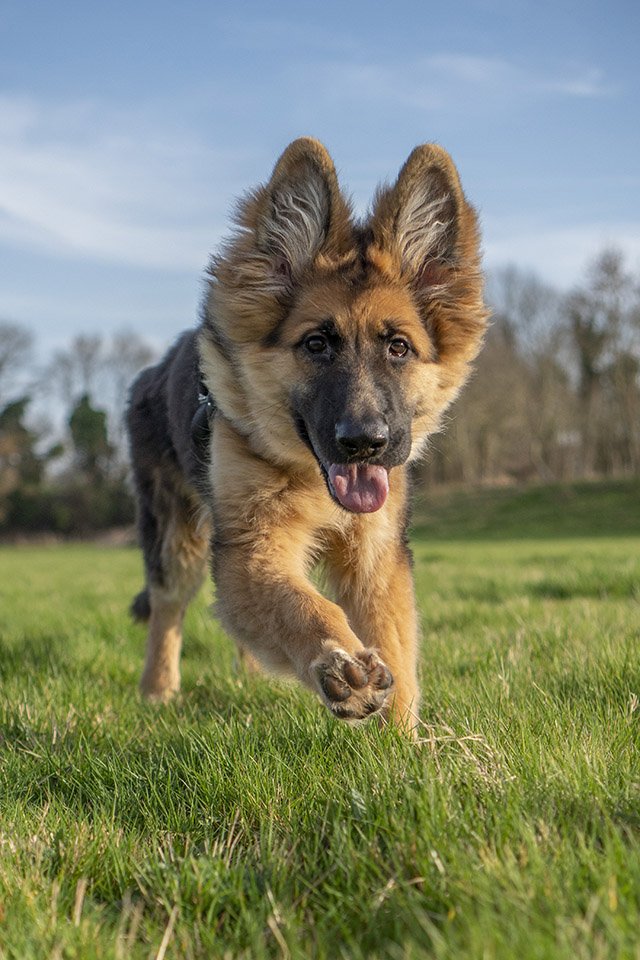
Sony E 35mm F1.8 (Shot on a6400) @ 35mm | 1/4000 | f/2.8 | ISO 320 | Cropped + Shadows Recovered in LR | ** Full Resolution SOOC Download: JPEG | RAW

Sony E 35mm F1.8 (Shot on a6500) @ 35mm | 1/1250 | f/1.8 | ISO 320 | ** Full Resolution SOOC Download: JPEG | RAW
Pros: Build quality, size, maximum aperture of f/1.8, silent AF, pleasing bokeh, price
Cons: Slow AF performance, chromatic aberrations
Recommended Reviews: Matthew Durr | Christopher Frost (YouTube)
Sample Photos: Flickr
Minimum Focusing Distance: 0.3m (0.99ft)
Minimum Aperture: f/22
Maximum Aperture: f/1.8
Aperture Blades: 7
Auto Focus: Yes
Stabilization: Yes
Filter Thread Size: 49mm
Length: 45mm (1-13/16 in.)
Diameter: 63mm (2-1/2 in.)
Weight: 154g (5.5oz.)
Sigma 30mm f/1.4 DC DN Contemporary
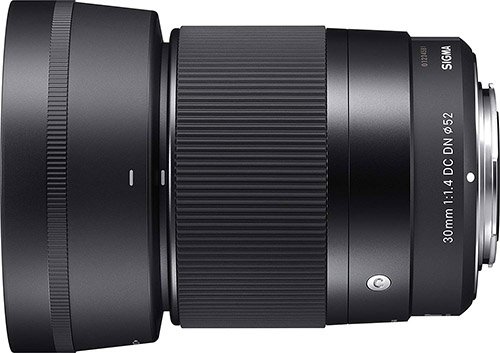
The Sigma 30mm F1.4 DC DN Contemporary lens is one of the sharpest lenses available for Sony E-mount and their APS-C range of cameras. It’s even sharper and offers better contrast than the more expensive Sony E 35 F1.8 lens above. A new firmware update has also addressed earlier autofocus issues, although the Sony E 35mm F1.8 is still slightly faster and more accurate when it comes to focusing.
As to be expected with such a wide lens, there is some vignetting when shooting wide-open, with around 1 1/3 stops light lost in the extreme corners. However, stop down to f/1.8 and you’ll already see a big improvement here. There is some lateral CA but this is easily removed in post or corrected in camera with JPEGS. Barrel distortion is definitely present but again this can be corrected in camera or in post.
When shooting wide-open at f/1.4 the central sharpness from this lens needs to be seen to be believed as does the creamy smooth bokeh, you’ll need to step down to f/2.8 to achieve the same levels of sharpness with the Sony E 35mm F1.8.
There’s no doubt that this is a brilliant lens and it’s one that I’ve now added to my own gear bag.
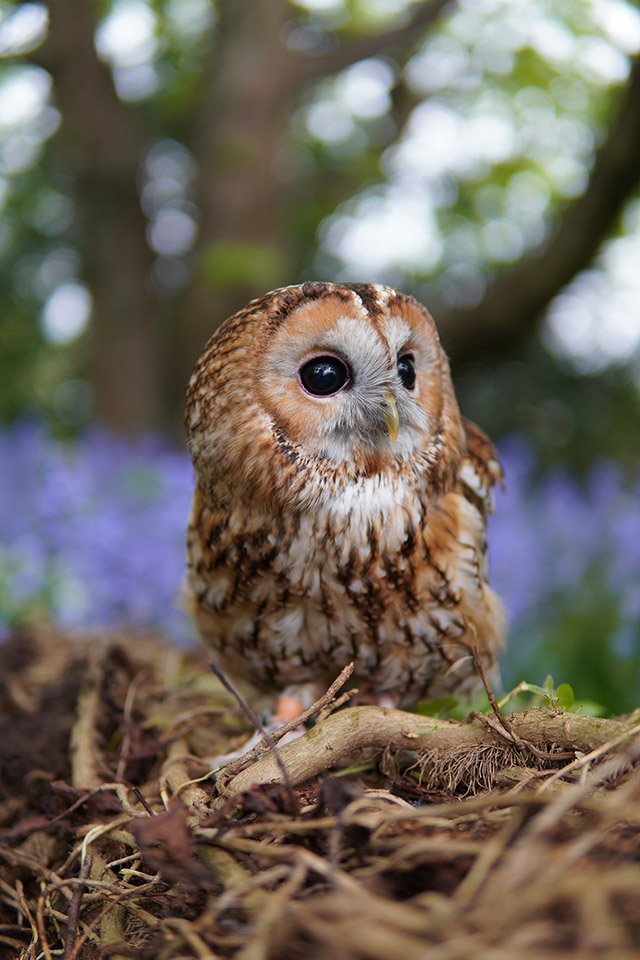
Sigma 30mm F1.4 DC DN (Shot on a6400) @ f/1.4 | 1/400 | ISO 160 | Full Resolution SOOC Download: JPEG | RAW **
Pros: Sharpness, size, price, bokeh
Cons: Vignetting, distortion
Recommended Reviews: Lavikka Photography (YouTube) | DPReview
Sample Photos: Flickr
Lens Construction: 9 elements in 7 groups
Minimum Focusing Distance: 30cm / 11.8in.
Minimum Aperture: f/16
Maximum Aperture: f/1.4
Aperture Blades: 9 rounded
Auto Focus: Yes
Stabilization: No
Filter Thread Size: 52mm
Length: 73.3㎜ / 2.9in
Diameter: 64.8㎜ / 2.55in.
Weight: 265g/ 9.3oz.
Sony E 50mm F1.8 OSS (SEL50F18)
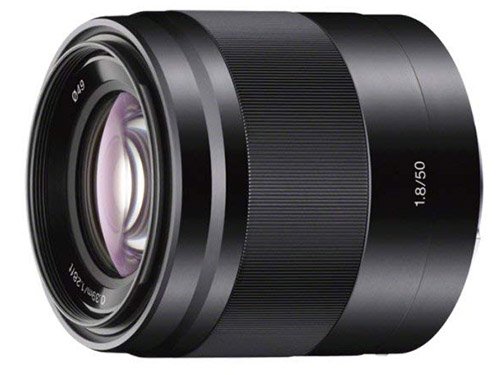
The Sony 50mm f/1.8 OSS lens is one of the best lenses for shooting portraits on the Sony a6400. It’s an APS-C lens which provides a full-frame equivalent focal length of 75mm, putting it very close to 85mm which many shooters prefer for portraits.
Thanks to its wide aperture of f/1.8 this lens is capable of producing some very nice bokeh. The lens is also very sharp even at f/1.8 in both the center of the frame and the corners, and this only gets better all the way down to f/11 when diffraction starts to kick in. There is a little purple fringing wide-open but nothing to worry about and this is also corrected if you are shooting in JPEG mode with in-camera corrections turned on.
There is a little vignetting at f/1.8 but step down to f/2.8 and it’s gone, distortion is also well controlled. There is some flare when shooting directly into bright light sources but nothing extreme that you will need to worry about.
Pros: Sharpness across the frame, build quality, price, bokeh, lightweight
Cons: Slow autofocus in low light
Recommended Reviews: Christopher Frost (YouTube)
Sample Photos: Flickr
Minimum Focusing Distance: 0.39m (1.28ft)
Minimum Aperture: f/22
Maximum Aperture: f/1.8
Aperture Blades: 7
Auto Focus: Yes
Stabilization: Yes
Filter Thread Size: 49mm
Length: 62 mm (2-1/2 in.)
Diameter: 62 mm (2-1/2 in.)
Weight: 202g (7.2oz.)
Sigma 56mm f/1.4 DC DN Contemporary
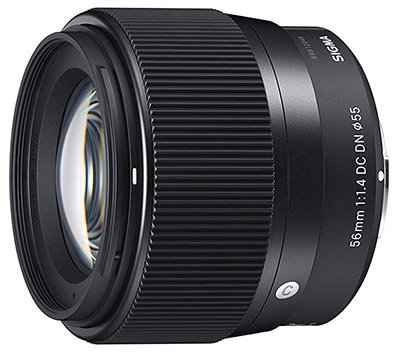
Just like both the Sigma 16mm and the 30mm, the Sigma 56mm f/1.4 DC DN Contemporary lens delivers level of sharpness that need to be seen to be believed. Central sharpness is excellent from f/1.4 right through to f/11, and it is still very good even at f/16. The extreme edges are very good from f/1.4 to f/2.8 and excellent from f/4 to f/11. When compared to the Sony E 50mm F1.8, the Sigma is significantly sharper.
Focusing is both fast and quiet, flare well controlled and the build quality is very high. The bokeh is is very smooth making this an excellent choice for a portrait lens. Chromatic aberration, mild vignetting and distortion is present, but in-camera corrections help to address these and if you shoot raw you can also correct in post.
With a 35mm equivalent focal length of 84mm this lens is ideal for portrait photography. If money were no object I’d certainly like to own one.
Pros: Very sharp, price, build quality, bokeh
Cons: Vignetting, CA
Recommended Reviews: Technology Mafia (YouTube) | Camera Labs
Sample Photos: Flickr
Lens Construction: 10 elements in 6 groups
Minimum Focusing Distance: 50cm / 19.7in.
Minimum Aperture: f/16
Maximum Aperture: f/1.4
Aperture Blades: 9 rounded
Auto Focus: Yes
Stabilization: No
Filter Thread Size: 55mm
Length: 59.5mm / 2.3in
Diameter: 66.5mm / 2.6in.
Weight: 280g / 9.9oz.
Sony FE 85mm F1.8 (SEL85F18)
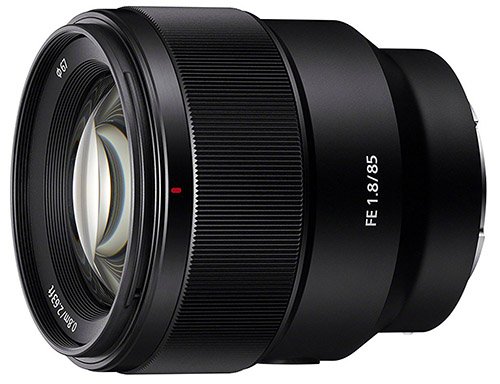
The Sony FE 85mm F1.8 is a full-frame lens but it still works perfectly on the Sony a6400. Because it’s a full-frame lens if you mount this to the Sony a6400 or another APS-C sensor camera then it will work more like a 130mm lens which will put you pretty close to your subject. This lens does not have OSS built-in, but thanks to the wide f/1.8 aperture you can shoot at higher shutter speeds to eliminate any movement.
This lens is not as large, heavy or as ridiculously sharp as its larger FE 85mm G Master brother, but it certainly does not disappoint for the price. What is surprising about this lens is that the autofocus is actually faster than the GM version. The bokeh isn’t quite as smooth as the GM but it certainly comes very close. I own this lens myself and certainly have no plans to sell it anytime soon.
This lens is also perfect for pet portraits. Here’s a shot of my dog Frank at 9 weeks of age and a shot from a portrait workshop that I did.
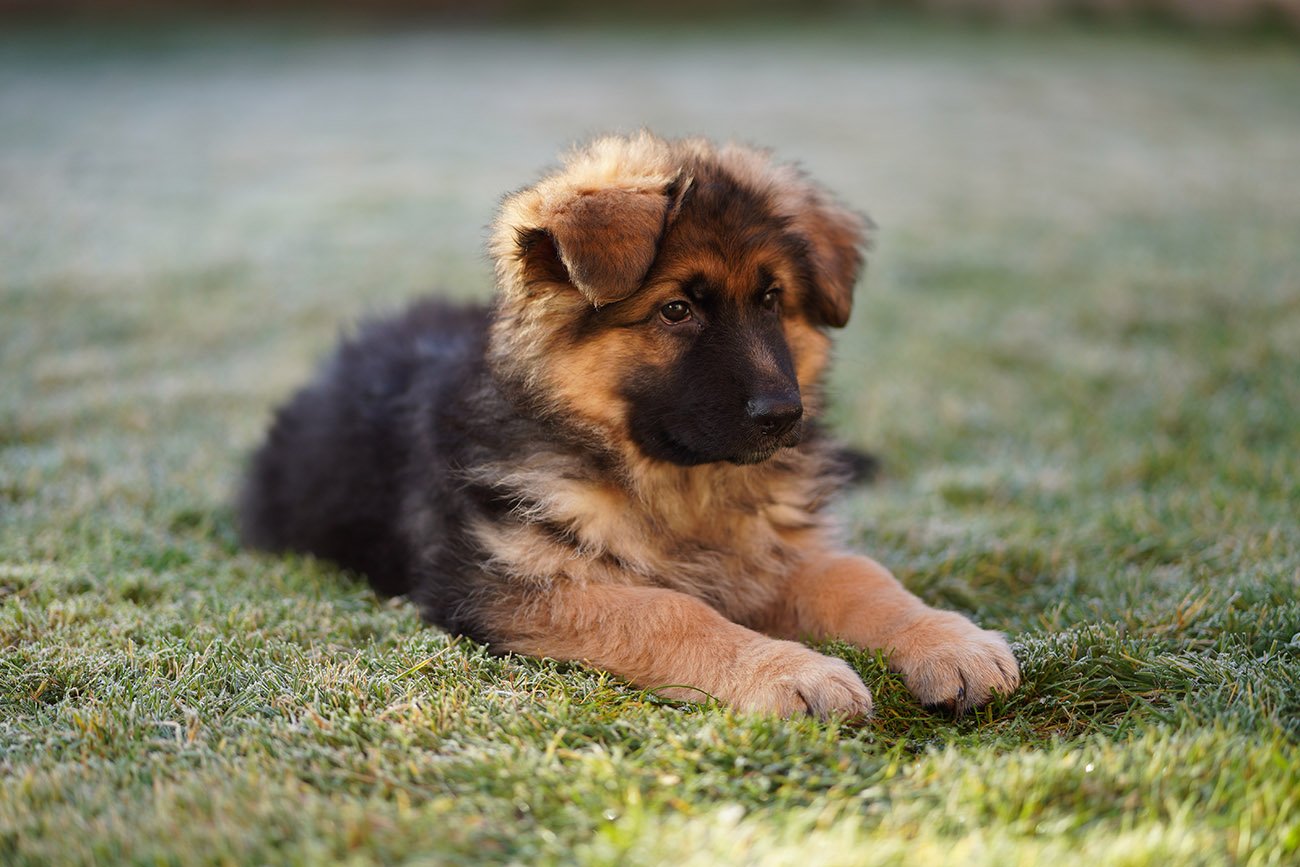
Sony FE 85mm F1.8 (Shot on a7III) @ 85mm | 1/1000 | f/1.8 | ISO 250 | ** Full Resolution SOOC Download: JPEG | RAW

a7R III + FE 85mm F1.8 | @ 1/400 | f/1.8 | ISO 100 | Cropped | ** Full Resolution SOOC Download: JPEG | RAW
Pros: Build quality, sharpness, bokeh, distortion, price
Cons: Purple fringing at large apertures, flare resistance
Recommended Reviews: Jannik Peters | Christopher Frost (YouTube)
Sample Photos: Flickr
Minimum Focusing Distance: 0.8 m (2.63 ft)
Minimum Aperture: f/22
Maximum Aperture: f/1.8
Aperture Blades: 9 circular
Auto Focus: Yes
Stabilization: No
Filter Thread Size: 67 mm
Length: 82 mm
Diameter: 78 mm
Weight: 371 g (0.82 lbs)
Macro Lenses
Macro lenses are often used to take photos of things close up like bugs, food, or generally anything that you would like to blow up really big to see as much detail as possible.
A macro lens should have the ability to focus from infinity to 1:1 magnification at the closest focusing distance, this means that the size of the image in real life is the same size as it is reproduced on the sensor of your camera.
I’ve created a guide for Sony E-mount macro lenses where you’ll find additional buying advice along with all of the macro lenses available for Sony E-mount.
These are some of the most popular macro lenses for the Sony a6400:
Sony E 30mm F3.5 Macro (SEL30M35)
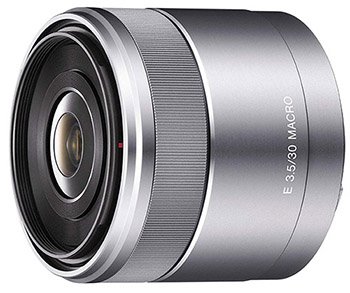
The Sony E 30mm F3.5 Macro APS-C lens is the most affordable E-mount macro lens available right now with a 1:1 magnification ratio. This lens is well built, compact and light in weight but unfortunately it does not have optical image stabilization (OSS) built in, so you will need to use a higher shutter speed to compensate for camera shake if you are shooting hand-held.
30mm is actually quite a short focal length for a macro lens, and with a minimum focusing distance of only 9.5cm from the camera’s sensor you will need to be very close to your subject to get 1:1 magnification. This should be no trouble if your subject is not living, but for bugs it might be a challenge. You will also start to block the light from reaching your subject when you are so close and also risk casting a shadow.
Central sharpness is very good at f/3.5 and improves down to f/8, whereas the edges are a little softer but for macro work where your subject is normally in the center of your frame this will probably be of no concern. CA is well controlled in the center of the frame, but could be better towards the edges where you will notice some color fringing in high contrast scenes. Flare is well controlled.
The autofocus is fast and quiet, which is definitely important if you don’t want to scare off your subject. Personally I prefer to use focus peaking and focus manually when shooting macro, as with the autofocus it’s always very difficult to nail focus on the eyes when shooting very small creatures like butterflies.
Unless your budget stretches to one of the two macro lenses that I’m about to talk about below, then this really is your best choice for a macro lens on the Sony a6400. That is unless you don’t like the silver color, as unfortunately this lens is not available in black which I find to be an odd omission by Sony.
Pros: Build quality, size, sharpness, 1:1 magnification, price
Cons: Edge sharpness, small working distance
Recommended Reviews: Technology Mafia (YouTube) | ePhotozine
Sample Photos: Flickr
Maximum Magnification Ration: 1:1
Minimum Focusing Distance: 0.095m (0.32ft)
Minimum Aperture: f/22
Maximum Aperture: f/3.5
Aperture Blades: 7
Auto Focus: Yes
Stabilization: No
Filter Thread Size: 49mm
Length: 55.5 mm (2-1/4in.)
Diameter: 62.0 mm (2-1/2in.)
Weight: 138g (4-7/8oz.)
7Artisans 60mm Macro Lens
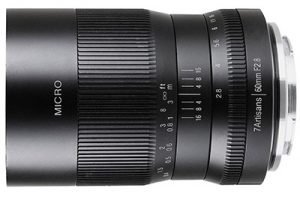
This manual focus 60mm F2.8 APS-C macro lens has been designed exclusively for mirrorless cameras.
It features a minimum 26cm (10in) focusing distance, F2.8 to F16 aperture, 8 elements in 7 groups, a 39mm filter size, de-clicked aperture ring, and 550g (19.4oz) weight.
The lens is made from aluminum alloy and supports extension attachments for shooting 2:1 and 3:1 macro images.
This is one of the most affordable macro lenses for the Sony a6400 and normally sells for around $160.
Recommended Reviews: Micael Widell (YouTube)
Sample Photos: 7Artisans | Flickr
Maximum Magnification Ration: 1:1
Minimum Focusing Distance: 0.26m (0.85ft)
Minimum Aperture: f/16
Maximum Aperture: f/2.8
Aperture Blades: n/a
Auto Focus: no, manual focus only
Stabilization: no
Filter Thread Size: 39mm
Length: n/a
Diameter: n/a
Weight: 550g (19.4oz.)
Laowa 65mm f/2.8 2x Ultra Macro APO
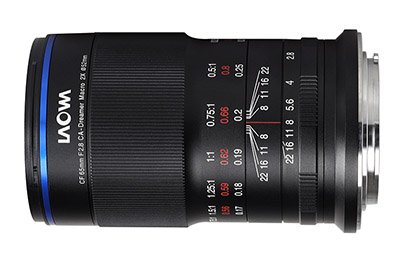
This is the first macro lens that Venus Optics has designed specifically for APS-C mirrorless cameras and it is the only macro lens on the market that is capable of producing 2X life-size images.
You won’t find an autofocus motor in this lens, both the focusing and aperture control is manual only. But with the help of Sony’s focus peaking you shouldn’t have any trouble nailing the focus on your subject.
The lens has excellent build quality and is very sharp wide-open at f/2.8 in the center even at 2x. The corners are a little softer wide-open but soon sharpen up at f/4. At 2x magnification the lens does start to get softer at f/5.6.
Chromatic aberration, distortion and vignetting are very well controlled even at f/2.8 although the lens is prone to flaring.
Recommended Reviews: Christopher Frost (YouTube) | Dustin Abbott
Sample Photos: Venus Lens
Maximum Magnification Ration: 2:1
Minimum Focusing Distance: 17cm / 6.69 in. (2X)
Minimum Aperture: f/22
Maximum Aperture: f/2.8
Aperture Blades: 9
Auto Focus: No, manual focus only
Stabilization: No
Filter Thread Size: 52mm
Length: 100mm
Diameter: 57mm
Weight: 335g / 11.81oz
Price Check & Buyer Reviews for Laowa 65mm F2.8 2x Ultra Macro APO
At: Amazon | B&H Photo | Venus Lens
Sony FE 90mm F2.8 Macro G OSS (SEL90M28G)
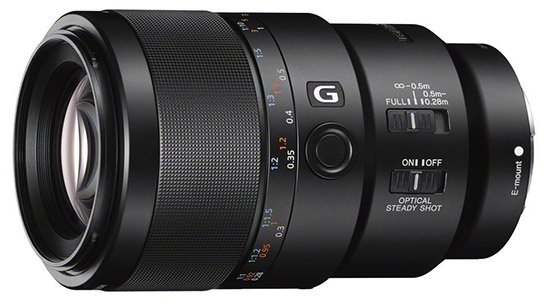
The Sony FE 90mm f/2.8 Macro G OSS lens is a full-frame lens and one of the sharpest lenses that Sony has ever built. DxOMark reviewed this lens and said that its outstanding, scoring higher marks than both the Canon and Nikon equivalents.
Mounted to an APS-C camera like the Sony a6400 and you will have an equivalent full-frame focal length of 135mm which gets you very close to your subject whilst maintaining a comfortable working distance.
It is very hard to find fault with this lens but if I’m being very picky then AF performance could be faster and the manual focus ring adjustments could be finer for more precision. That said, for macro work I’ll normally adjust the focus by moving the camera back and forth and whilst making use of focus peaking to let me know when the focus is where I’d like it to be. This lens also has optical stabilization built in, making it even easier to get tack sharp images with slower shutter speeds.
If you are looking for a dedicated macro lens, or a lens that can combine both macro and portrait photography roles, then look no further than the 90mm F2.8 Macro G OSS lens. I own this lens myself and have no plans to let it go anytime soon.
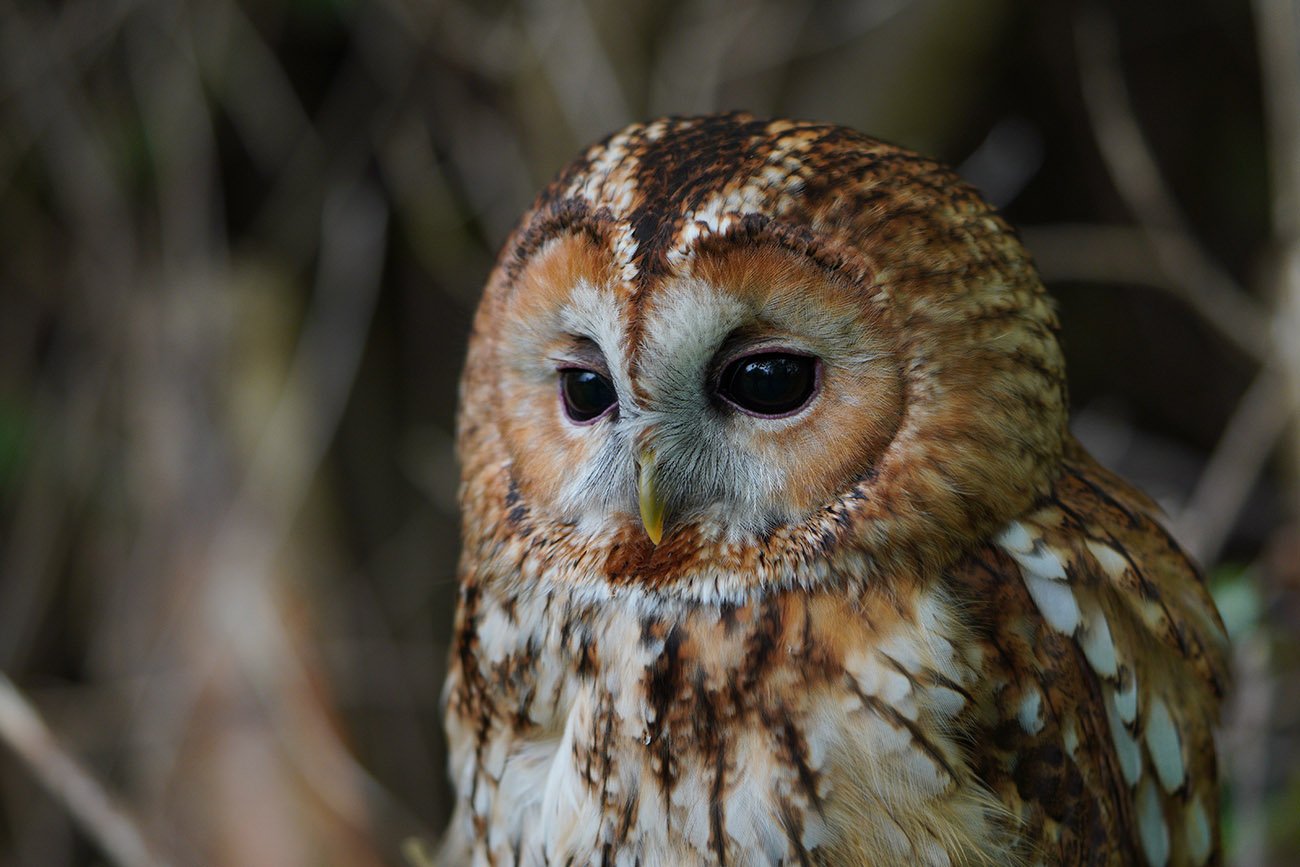
Sony FE 90mm F2.8 Macro (Shot on a6400) @ 1/250 | f/2.8 | ISO 400 | ** Full Resolution SOOC Download: JPEG | RAW

Sony FE 90mm F2.8 Macro (Shot on a6400) @ 1/250 | f/2.8 | ISO 1250 | Cropped | ** Full Resolution SOOC Download: JPEG | RAW

Sony FE 90mm F2.8 Macro (Shot on a7R III) @ 1/500 | f/2.8 | ISO 320 | Cropped | ** Full Resolution SOOC Download: JPEG | RAW
Pros: Incredible sharpness at all apertures, excellent color rendition, CA is well controlled, very well built, price
Cons: Autofocus isn’t the fastest, manual focus could allow for finer adjustments
Recommended Reviews: Jordan Steele | DxOMark | Philip Reeve
Sample Photos: Flickr
Maximum Magnification Ration: 1:1
Minimum Focusing Distance: 0.28 m (0.92 ft)
Minimum Aperture: f/22
Maximum Aperture: f/2.8
Aperture Blades: 9 circular
Auto Focus: Yes
Stabilization: Yes
Filter Thread Size: 62 mm
Length: 130.5 mm
Diameter: 79 mm
Weight: 602g (1.33 lbs)
Sigma 70mm F2.8 DG Macro Art
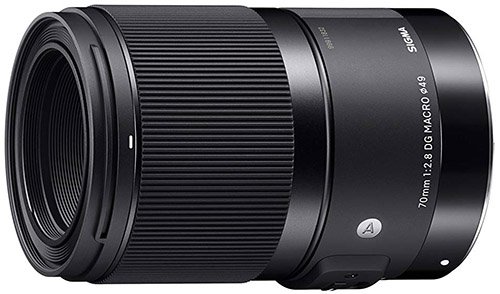
The Sigma 70mm F2.8 DG Macro lens for Sony E-mount (full-frame) is the first macro lens from Sigma that has been adapted to Sony E-mount. However, the word adapted here is very important since the E-mount version of this lens has been adapted from their Canon and Sigma versions that were originally designed for SLR cameras and not mirrorless. The additional adapter that is built onto the back of the lens body for the E-mount does add extra weight and length to the lens over its SLR equivalents.
Still, despite this lens being adapted from their SLR versions, it is a beautiful lens that costs almost half the price of the Sony FE 90mm F2.8 G OSS macro lens. The images that it produces are razor sharp across the frame, chromatic aberration is well controlled as is distortion. The bokeh is silky smooth and the lens feels like all Sigma Art lenses do, extremely well built!
Mounted to an APS-C camera like the Sony a6400 and you will have an equivalent full-frame focal length of 105mm which gets you very close to your subject. Here’s a shot of a butterfly I took with this lens mounted to my Sony a6500.

Sigma 70mm F2.8 Macro (Shot on a6500) @ 1/250 | f/8 | ISO 160 | Cropped | ** Full Resolution SOOC Download: JPEG | RAW
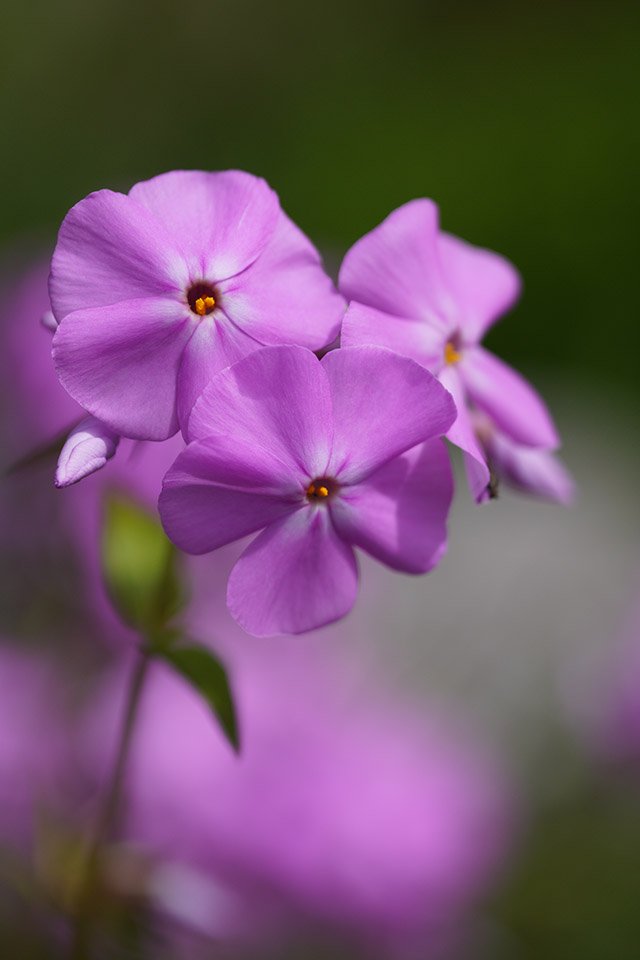
Sony a6400 + Sigma 70mm F2.8 DG Macro Art @ 1/4000 | f/2.8 | ISO 125 | Full Resolution SOOC Download: JPEG | RAW **
Autofocus on this lens is not the fastest, you certainly won’t be nailing sharp images of any bugs in flight. However, for macro work I’m using this lens in manual mode 99% of the time so I’m not worried about AF performance. The large focusing ring is extremely smooth and gives you a lot of precision when manually focusing, however this precision comes at a price, as the focus ring requires around 10 twists of the wrist to go from minimum to maximum distance.
Unlike the Sony 90mm Macro, the Sigma does extend when you focus. However, it never extends further than the lens hood and has never been an issue for me personally. As it’s a 70mm lens with a minimum focusing distance of 0.25m, you will need to get very close to your subject for 1:1 images, so there is always a risk of casting a shadow or scaring off your subject. I own this lens myself and for the price you really can’t go wrong with it.
Pros: Extremely sharp, color rendition, chromatic aberration, build quality, price
Cons: Autofocus, manual focus ring
Recommended Reviews: My Review
Sample Photos: My Review
Maximum Magnification Ratio: 1:1
Minimum Focusing Distance: 0.25m (0.82ft)
Minimum Aperture: f/22
Maximum Aperture: f/2.8
Aperture Blades: 9 circular
Auto Focus: Yes
Stabilization: No
Filter Thread Size: 49 mm
Length: 130 mm (min) 181 mm (max)
Diameter: 70.8 mm
Weight: 622 g (1.37 lbs) with lens hood
Telephoto Lenses
If you are looking for a lens with a little more reach perhaps for shooting wildlife or sports then you will want to consider a telephoto lens.
Currently the longest APS-C telephoto lens goes up to 350mm, if you want a longer focal length than this then you’ll need to look at full-frame telephoto lenses which go up to 600mm.
Sony E 55-210mm F4.5-6.3 OSS (SEL55210)
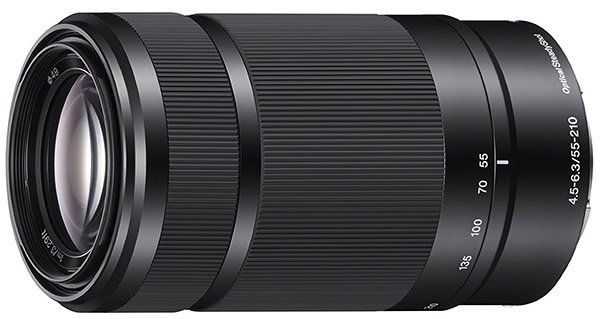
The Sony E 55-210mm F4.5-6.3 OSS lens covers a very useful focal range. Sure it’s not as wide as the 18-200mm, but it does offer comparable image quality and at much more pocket friendly price too.
Build quality is very good and the autofocus is fast, accurate and virtually silent. Optical image stabilization is also very useful when shooting handheld, especially at the longer end of the zoom range.
From 55mm to 120mm the lens is very sharp in the center of the frame when shooting wide-open, the corners are a little softer but stepping down one stop soon improves them. At 210mm the center is a little softer but is still perfectly sharp, at least it is to my own eyes. There are signs of both vignetting and chromatic aberration, but the in-camera corrections will take care of this for JPEG shooters. If you shoot raw then you can make use of LR profiles to correct this.
I do own this lens myself and it is my preferred choice of lens if the 18-135mm is not quite long enough for my needs. It’s a super little all-round lens that can shoot pretty much anything that you can throw at it. Here are a couple of shots that I have taken with it mounted to my a6400 and a6500.
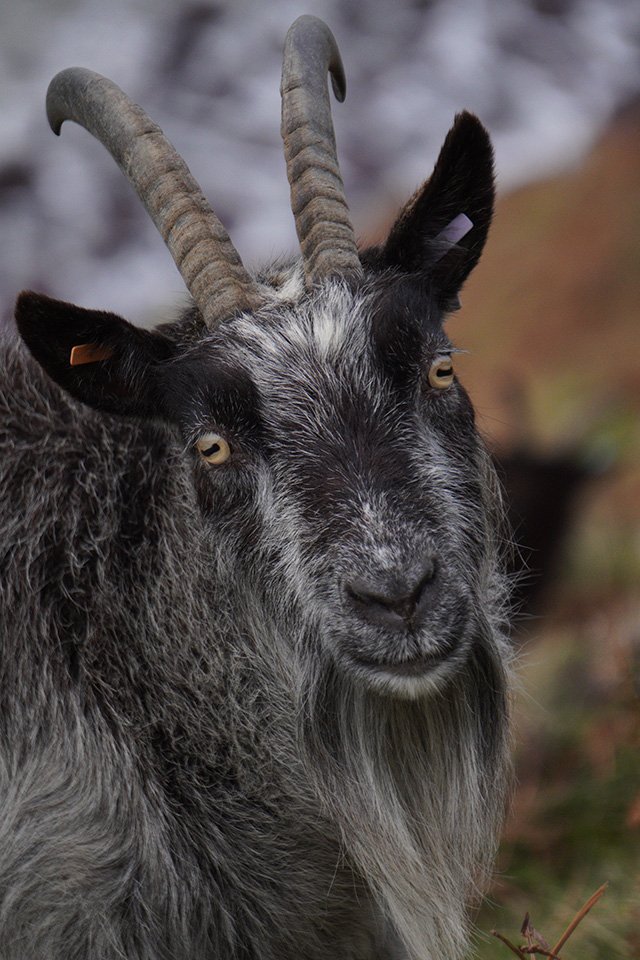
Sony E 55-210mm (Shot on a6400) @ 210mm | 1/1000 | f/6.3 | ISO 1000 | Handheld | ** Full Resolution SOOC Download: JPEG | RAW
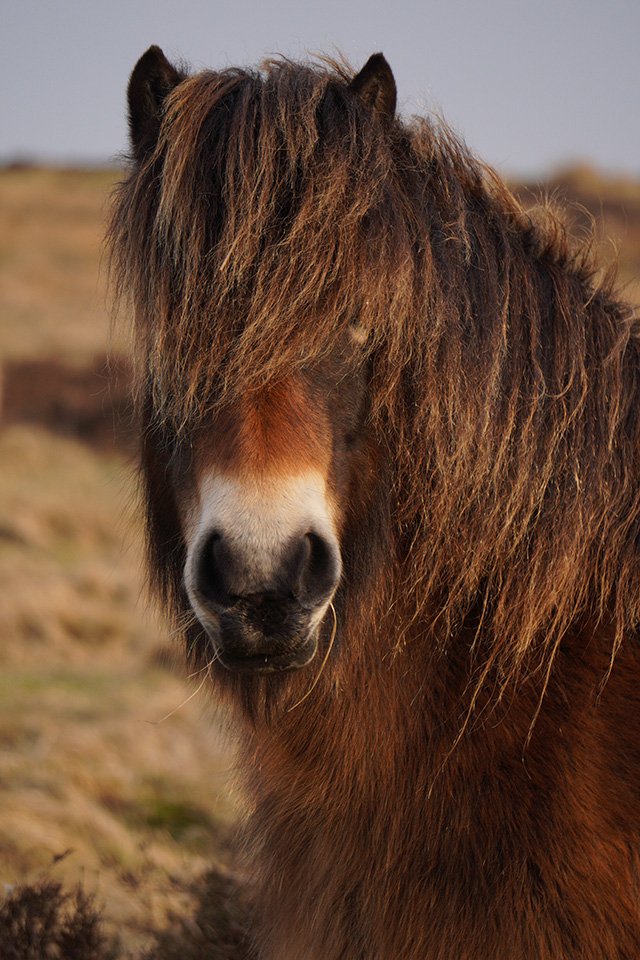
Sony E 55-210mm (Shot on a6400) @ 150mm | 1/640 | f/5.6 | ISO 400 | Handheld | ** Full Resolution SOOC Download: JPEG | RAW
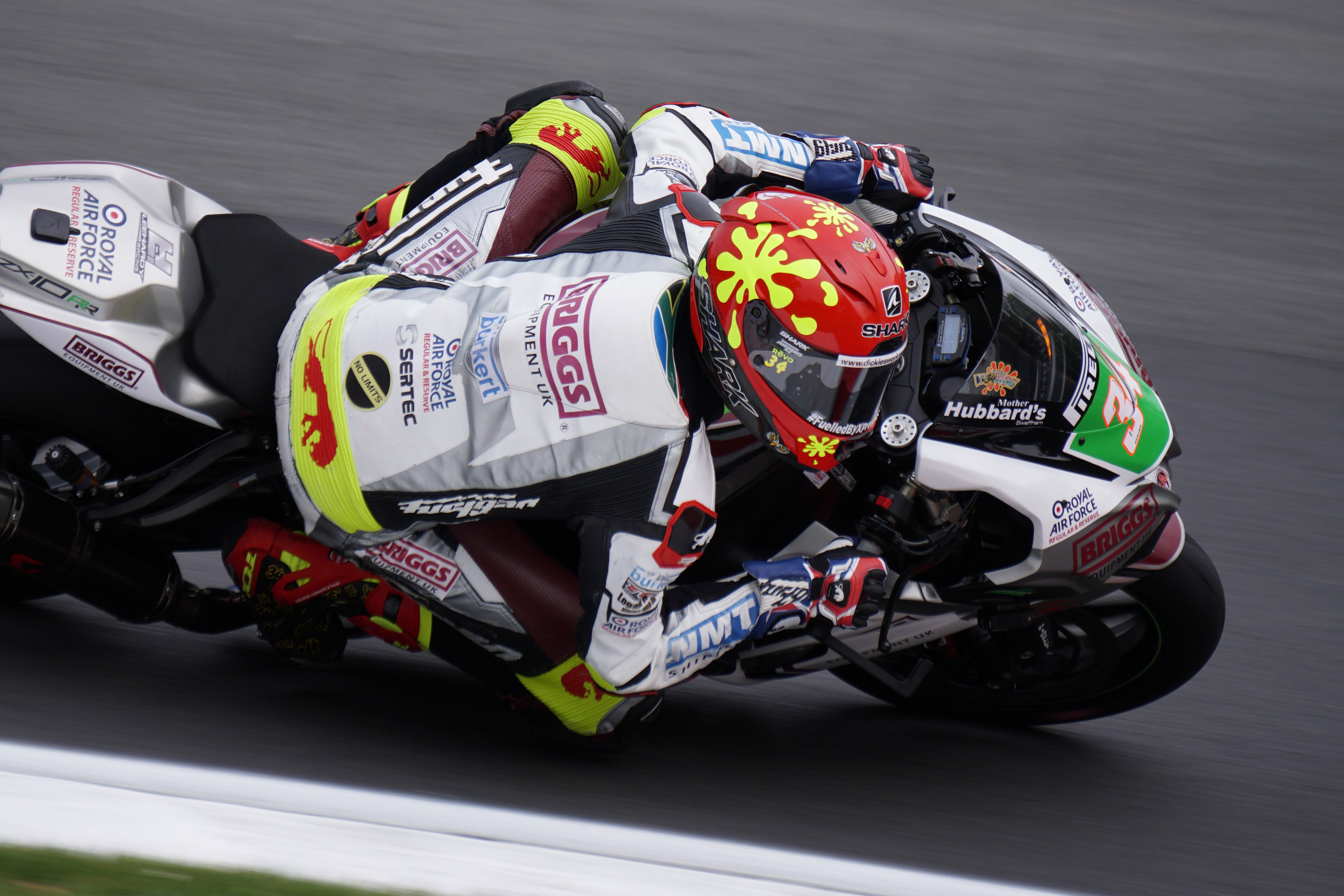
Sony E 55-210mm (Shot on a6500) @ 210mm | 1/250 | f/6.3 | ISO 200 | Handheld (I don’t provide full res images for superbike shots I’m afraid)
Pros: Price, central sharpness, weight, autofocus performance
Cons: CA, vignetting
Recommended Reviews: Jay SonyAlphaLab | Technology Mafia (YouTube) | John Sison (YouTube)
Sample Photos: Flickr
Minimum Focusing Distance: 1m (3.28ft)
Minimum Aperture: f/22-32
Maximum Aperture: f/4.5-6.3
Aperture Blades: 7
Auto Focus: Yes
Stabilization: Yes
Filter Thread Size: 49mm
Length: 108mm (4-3/8 in.)
Diameter: 63.8mm (2-5/8 in.)
Weight: 345g (12.2oz.)
Sony E 70-350mm F4.5-6.3 G OSS (SEL70350G)
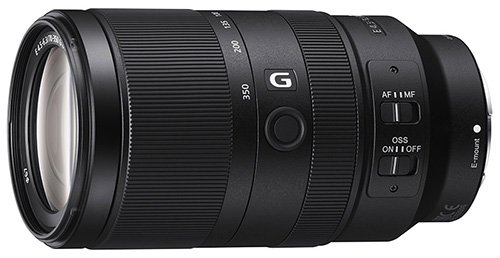
The Sony E 70-350mm F4.5-6.3 G OSS is currently the longest APS-C zoom lens that you can buy for the Sony a6400, if you want longer then you’ll need to look at the full-frame options.
I’ve not owned this lens for very long but I have been impressed by its compact size, weight and autofocus performance. It is a variable aperture lens and the maximum aperture at 350mm is f/6.3.
I have to admit to being a little disappointed that Sony decided not to include a focus limiter switch that you do find on the Sony FE 70-300 full-frame lens, but it’s not a major issue unless you make use of this often.
I decided to compare the autofocus performance of this lens with the Sony FE 70-300 and found they both offer similar levels of performance.
Here are a couple of sample photos that I’ve shot with this lens and the Sony a6400:
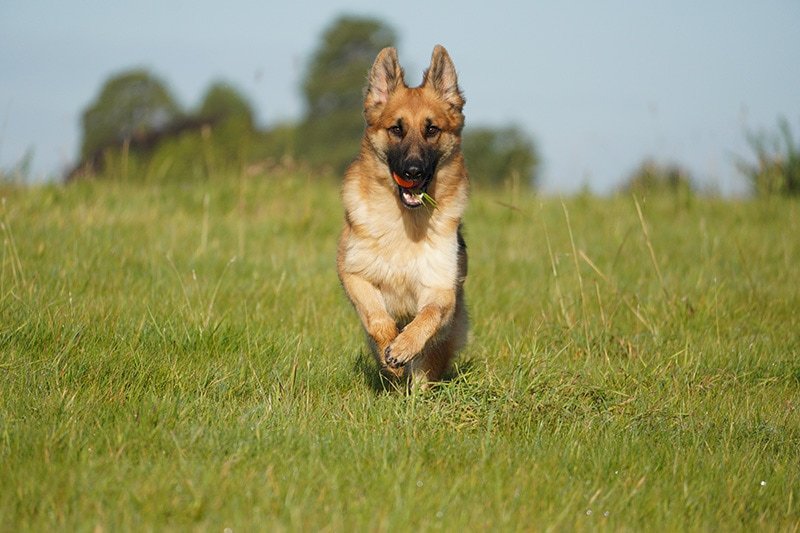
Sony a6400 + E 70-350 @ 350mm | 1/2000 | f/6.3 | ISO 500 | Full Resolution SOOC Download: JPEG | RAW **
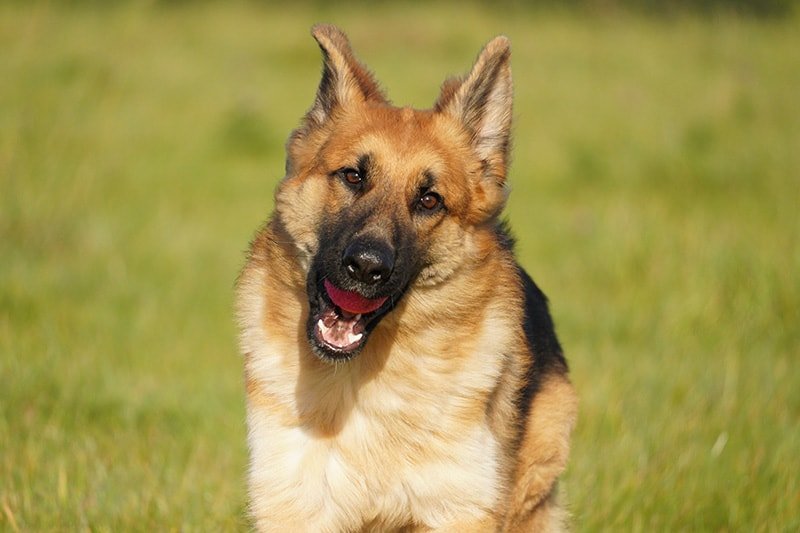
Sony a6400 + E 70-350 @ 350mm | 1/2000 | f/6.3 | ISO 640 | Full Resolution SOOC Download: JPEG | RAW **
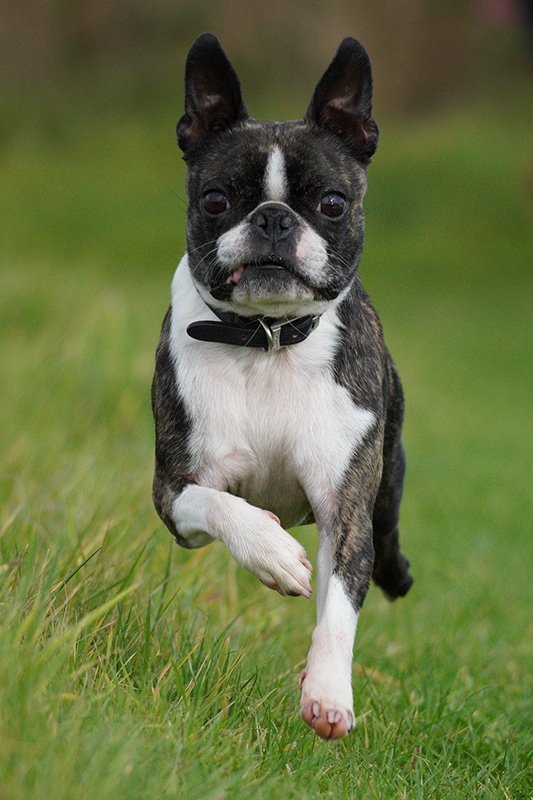
Sony a6400 + E 70-350 @ 210mm | 1/2000 | f/6.3 | ISO 1000 | Cropped | Full Resolution SOOC Download: JPEG | RAW **
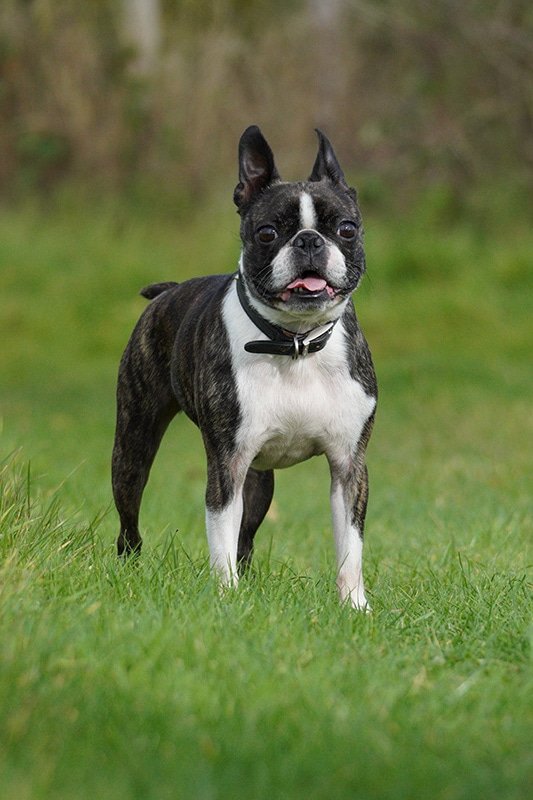
Sony a6400 + E 70-350 @ 160mm | 1/2000 | f/5.6 | ISO 1000 | Cropped | Full Resolution SOOC Download: JPEG | RAW **
And here’s one I shot with this lens on my a7R IV in crop mode:
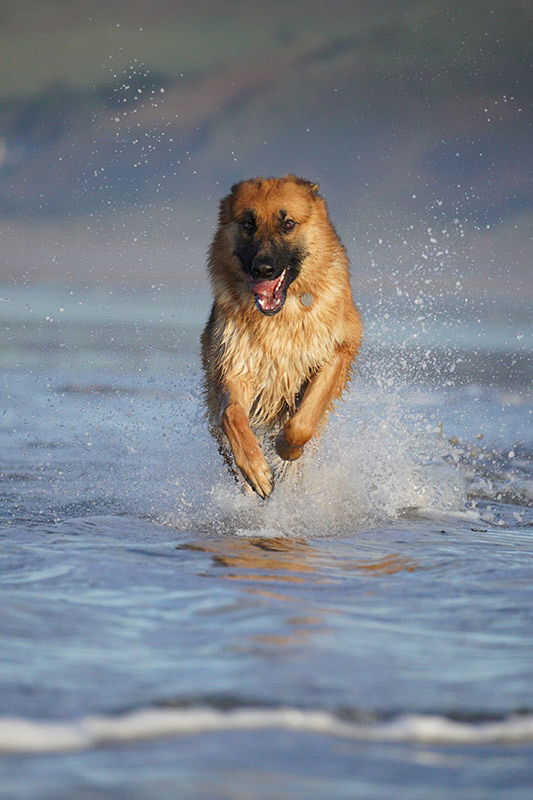
Sony E 70-350 G @ 350mm | 1/2000 | f/6.3 | ISO 1000 | Full Resolution SOOC Download: JPEG | RAW **
If you are looking for a high quality zoom lens for the a6400 then you don’t need to look any further than the E 70-350.
Pros: Very fast and quiet autofocus, lightweight and compact, sharpness
Cons: No focus limiter or panning modes
Recommended Reviews: Christopher Frost (Youtube) | Arthur R (YouTube)
Sample Photos: Sony Gallery
Format: APS-C
Lens Construction: 13 groups, 19 elements
Angle of View: 22°-4°40′
Aperture Blades: 7 circular
Minimum Aperture: f/4.5-6.3
Maximum Aperture: f/22-32
Minimum Focusing Distance: 3.61–4.93 ft (1.1–1.5 m)
Maximum Magnification Ratio: 0.75
Auto Focus: Yes
Stabilization: Yes
Filter Thread Size: 67mm
Length: 142mm
Diameter: 77mm
Weight: 625g / 22.1 oz
Sony FE F4.5-5.6 100-400mm G Master (SEL100400GM)
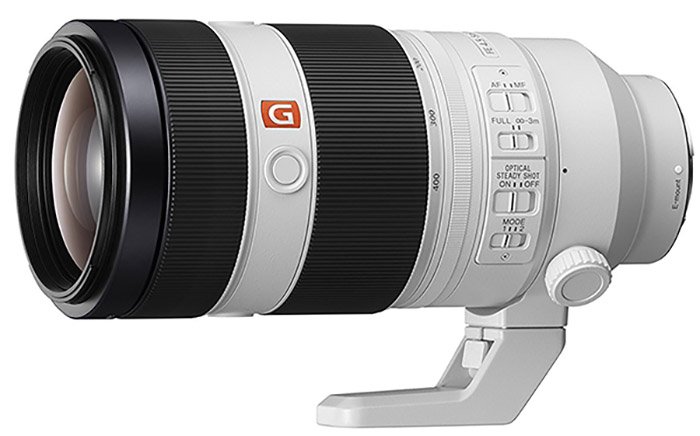
If you are looking for the best native 100-400mm zoom lens for shooting wildlife, sports and action, then look no further than the Sony FE 100-400mm f/4.5-5.6 GM OSS lens. I’ve owned this lens since it was released and it has rarely been off my camera since.
The Sony FE F4.5-5.6 100-400mm G Master lens is a full frame lens that will give an equivalent full-frame focal length on an APS-C camera like the a6400 of 150-600mm. The lens has a variable aperture of F4.5-5.6, an extremely fast and silent autofocus motor, and great build quality. The lens is also weather sealed against dust and moisture so you won’t need to pull out your plastic bag when the rain comes down.
Sharpness across the frame needs to be seen to be believed and DxOMark rate this as the sharpest lens in the 100-400mm focal range.
The lens is also compatible with the Sony FE 1.4x and 2.0x teleconverters, helping to extend its reach up to 560mm with the 1.4x and up to 800mm with the 2x (full-frame equivalent of 840mm for the 1.4x and 1200mm for the 2x). However, I’d recommend only using it with the 1.4x since with the 2x your aperture is pushed to f/11 and you’ll also find that the images produced are a little on the softer side.
Here are a few shots that I have taken with it:
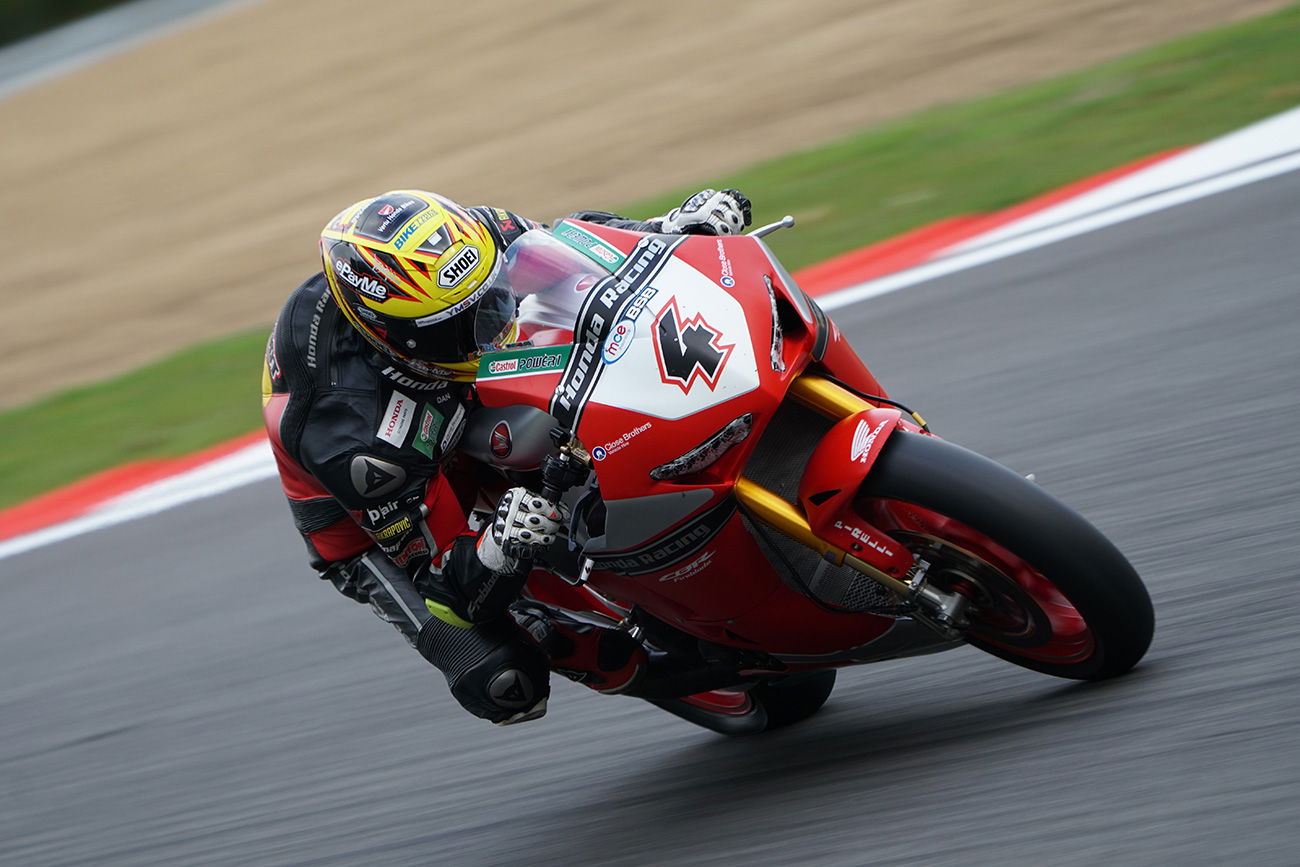
a6500 + 100-400 GM @ 345mm | 1/250 | f/5.6 | ISO 400 (I don’t provide full res images for superbike shots I’m afraid)
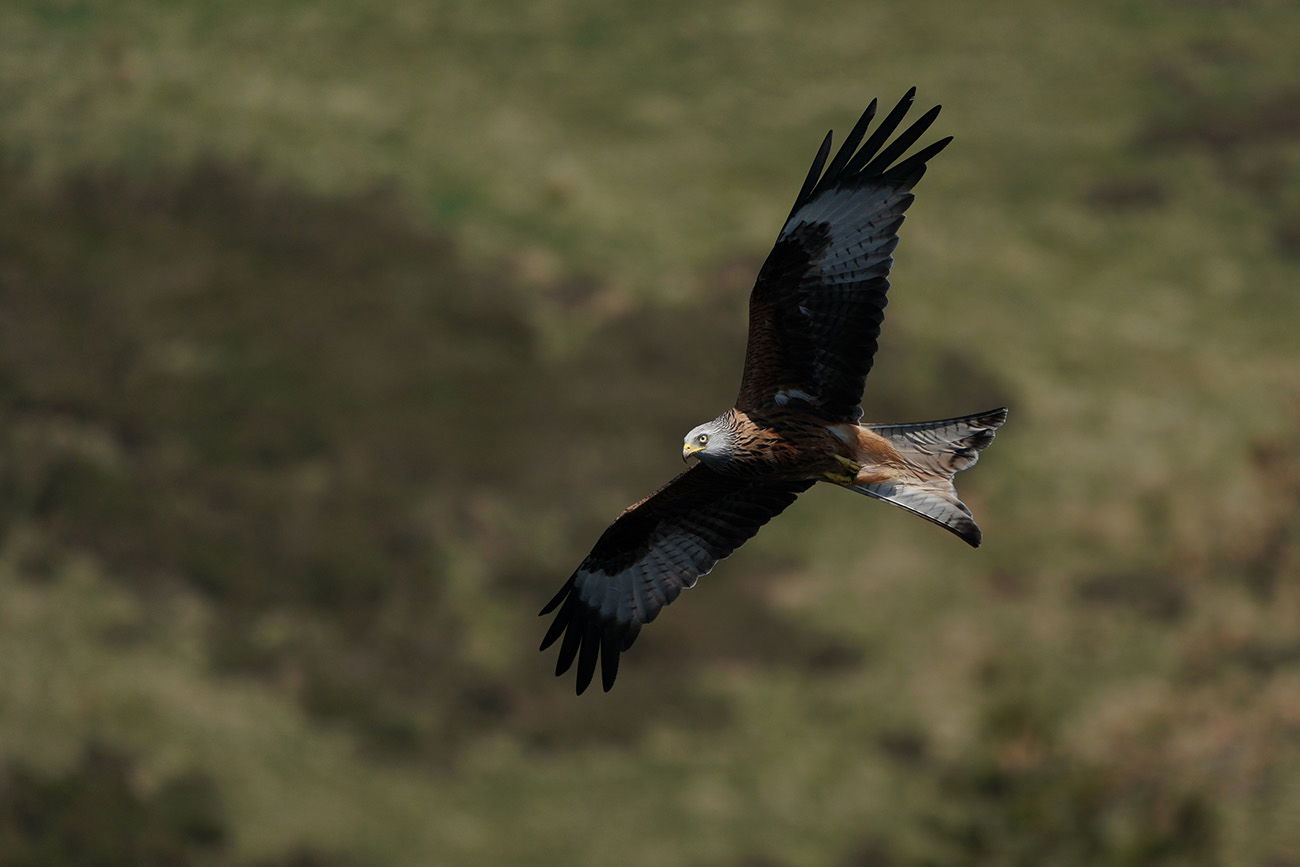
a9 + 100-400 GM @ 400mm | 1/1600 | f/5.6 | ISO 200 | Cropped | *Full Resolution Download: JPEG | RAW
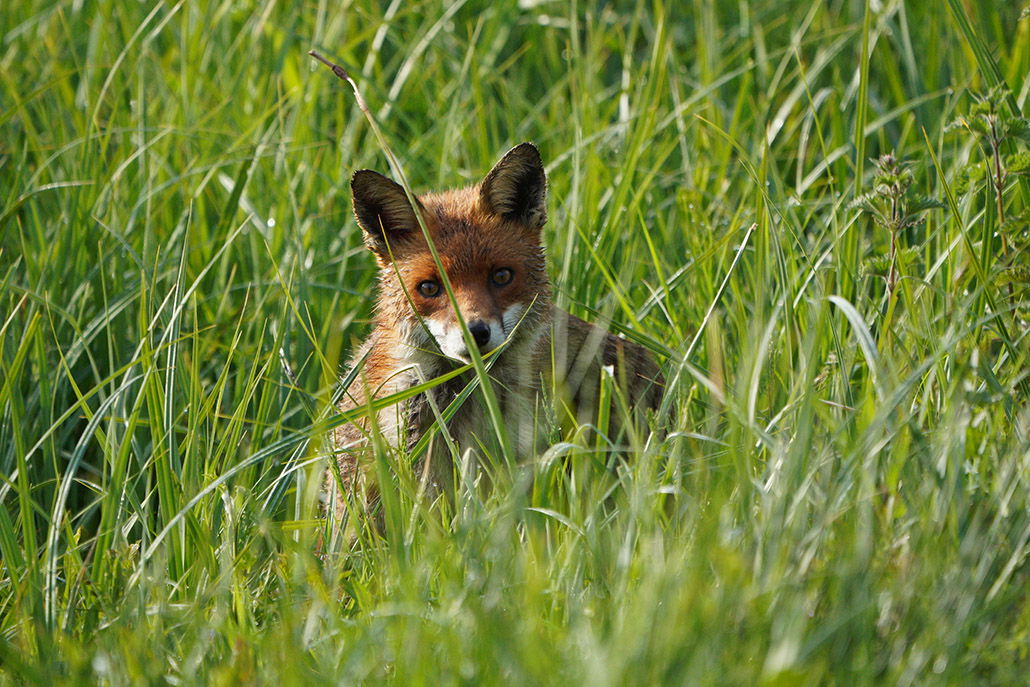
Sony a6400 + 100-400mm GM @ 400mm | 1/1250 | f/5.6 | ISO 800 | Full Resolution SOOC Download: JPEG
Pros: Fast autofocus, very sharp across the frame, color rendition, bokeh, build quality
Cons: Price
Recommended Reviews: My Review | DxOMark
Sample Photos: My Review Samples
Minimum Focusing Distance: 0.98 m (3.22 ft)
Minimum Aperture: f/32-40
Maximum Aperture: f/4.5-5.6
Aperture Blades: 9 circular
Auto Focus: Yes
Stabilization: Yes
Filter Thread Size: 77 mm
Length: 205 mm
Diameter: 93.9 mm
Weight: 1395 g (3.1 lbs) without tripod mount
Sony FE 200-600mm F5.6-6.3 G OSS (SEL200600G) Lens
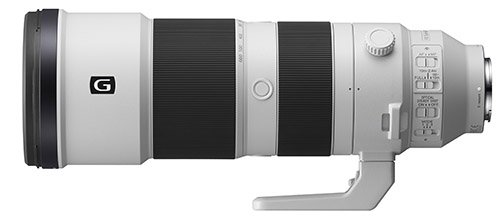
The Sony FE 200-600mm F5.6-6.3 G OSS lens has not been out for very long but it’s already proving itself to be an exceptional telephoto lens for wildlife photographers.
Since I enjoy shooting wildlife myself I ordered this lens as soon as it was announced and I’m currently working on a 200-600 vs 100-400 comparison.
With a focal range of 200-600mm and a maximum aperture of f/6.3 at 600mm this lens will help you to get closer to wildlife than ever before. If 600mm is not long enough then you can also add the 1.4x or 2.0x teleconverters.
This is a big lens and it weighs 2115g without tripod mount and is 318mm in length. It’s also an internal focusing lens and the short zoom throw makes going from 200mm to 600mm a breeze. Because it doesn’t extend it also balances very well on a gimbal.
At 600mm this lens is sharper than the Sony FE 100-400 + 1.4x is at 560mm. At 400mm this lens is also a touch sharper than the 100-400 which considering it’s a G lens and not a GM lens is really quite something.
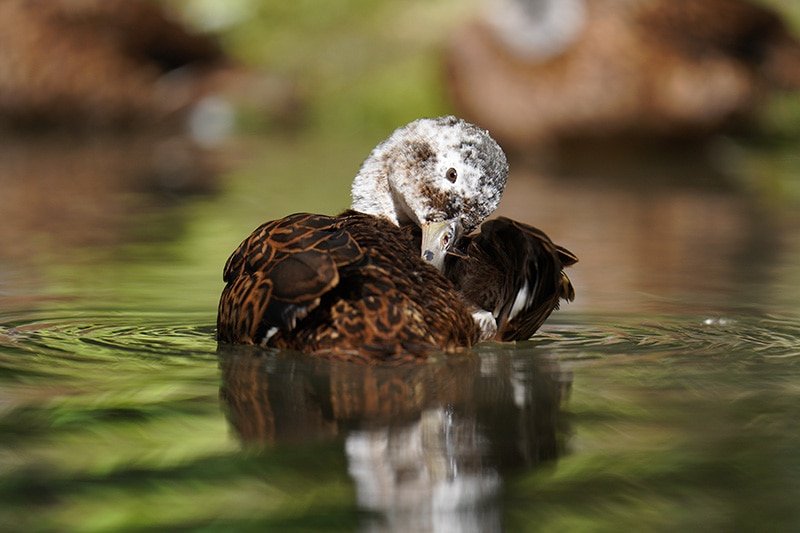
Sony a7 III + 200-600 @ 600mm | 1/1000 | f/6.3 | ISO 640 | Full Resolution SOOC Download: JPEG | RAW **
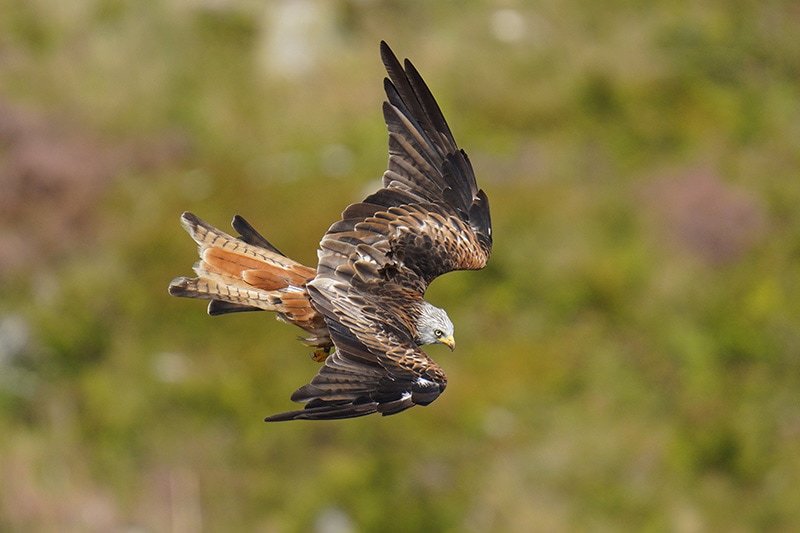
Sony a7III + 200-600 @ 600mm | 1/2000 | f/6.3 | ISO 640 | Cropped | Full Resolution SOOC Download: JPEG
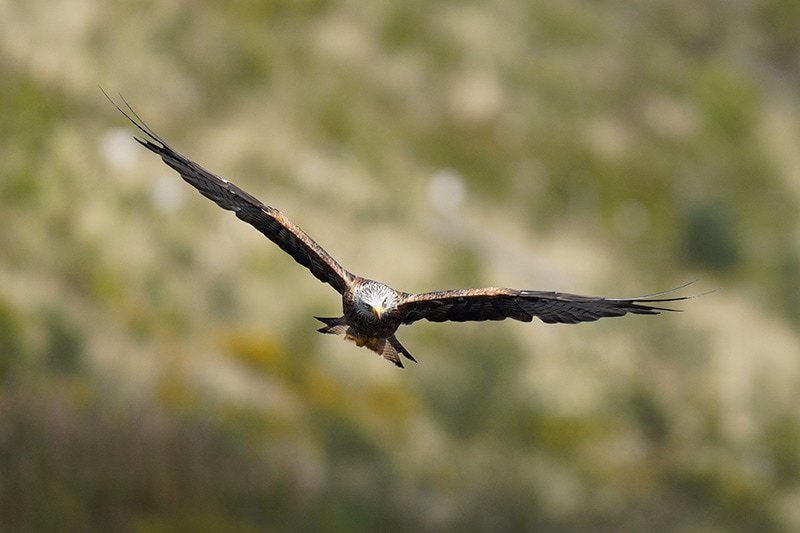
Sony a7III + 200-600 @ 600mm | 1/2000 | f/6.3 | ISO 800 | Cropped | Full Resolution SOOC Download: JPEG | RAW **
Pros: Internal zoom, sharpness, 1.4x & 2.0x teleconverter compatibility
Cons: Size, weight
Recommended Reviews: Mark Smith (YouTube)
Sample Photos: My Sample Gallery
Minimum Focusing Distance: 2.4m (7.88 ft)
Minimum Aperture: 32-36
Maximum Aperture: 5.6-6.3
Aperture Blades: 11 circular
Auto Focus: Yes
Stabilization: Yes
Filter Thread Size: 95mm
Length: 318 mm (12 5/8 in.)
Diameter: 111.5 mm (4 1/2 in.)
Weight: 2115g without tripod mount
Sigma 100-400mm F5-6.3 DG DN OS
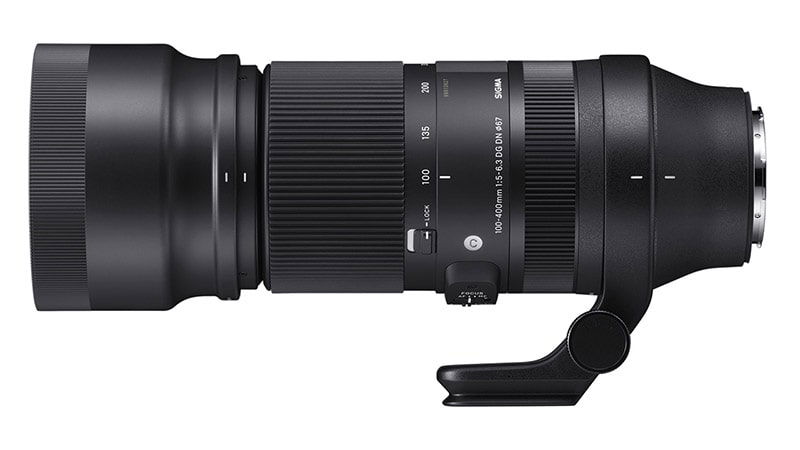
The Sigma 100-400mm F5-6.3 DG DN OS has not long been released, as soon as reliable information is known about this lens this section will be updated.
I have purchased this lens myself and the image quality is very good and extremely close to the Sony FE 100-400 lens.
Unfortunately the autofocus performance is not on par with the Sony. It misses more shots and if you are shooting bursts with AF-C priority set to balanced emphasis it struggles sometimes to lock-on and fire the shutter.
I will be doing a full review and comparison with the Sony FE 100-400 GM lens very soon.
Until then this first look video from Gordon Laing is worth watching:
Pros:
Cons:
Recommended Reviews:
Sample Photos: Sigma Gallery
Lens Construction: 22 elements in 16 groups
Angle of View (35mm): 24.4° – 6.2°
Aperture Blades: 9 rounded
Minimum Aperture: f/22-29
Maximum Aperture: f/5
Minimum Focusing Distance: 112 (Wide) – 160cm (Tele) / 44.1 – 63in.
Maximum Magnification Ratio: 1:4.1 (400mm)
Auto Focus: Yes
Stabilization: Yes
Filter Thread Size: 67mm
Length: 199.2mm / 7.8in.
Diameter: 86mm / 3.4in.
Weight: 1,140g / 40.2oz.
Website: Sigma 100-400mm F5-6.3 DG DN OS
Pancake Lenses
A pancake lens is typically a flat, thin lens and will normally have a wide focal length. If you are looking for a small discrete lens for street photography then pancake lenses can make a great choice.
Sony E 20mm F2.8 (SEL20F28)
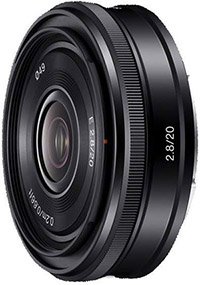
If you are looking for a discrete lens then they don’t get much smaller than the Sony E 20mm F2.8 lens that weighs only 69 grams (2.4oz) and is 20.4mm in length.
Autofocus is pretty fast and the minimum focus distance is just 20cm.
Sharpness in the center of the frame is good when shooting at the maximum aperture of f/2.8 and the edges are not much further behind. The lens is sharpest when stopped down to f/5.6.
Chromatic aberrations are fairly prevalent towards the frame edges when shooting wide open as is vignetting. At f/2.8 the corners are 2.48 stops darker than the center and this doesn’t balance out until you reach f/8.
There is some barrel distortion visible when shooting in RAW but for JPEG shooters this is corrected in-camera. The contrast is very good even when shooting directly into the sun and flare is also very well controlled.
Pros: Size, weight, central sharpness wide-open
Cons: Chromatic aberrations, vignetting, distortion
Recommended Reviews:
Sample Photos: Flickr
Minimum Focusing Distance: 0.66 ft (0.2 m)
Minimum Aperture: f/16
Maximum Aperture: f/2.8
Aperture Blades: 7 rounded
Auto Focus: Yes
Stabilization: No
Filter Thread Size: 49mm
Length: 13/16″ (20.4 mm)
Diameter: 2-1/2 (62.6 mm)
Weight: 2.4 oz (69 g)
Budget Lenses
If you are on a budget then take a closer look at some of these lenses from 7Artisans:
- 7Artisans 7.5mm f/2.8
- 7Artisans 12mm f/2.8
- 7Artisans 25mm f/1.8
- 7Artisans 35mm f/1.2
- 7Artisans 35mm f/2.0
- 7Artisans 50mm f/1.8
- 7Artisans 55mm f/1.4
- 7Artisans 60mm f/2.8 Macro
Sony a6400 FAQs
These questions come up quite often so here are my answers.
The Sony a6400 has an APS-C sized sensor and uses the Sony E-mount system. This means that it’s compatible with any of Sony’s E-mount lenses or even third-party E-mount lenses like Sigma or Rokinon.
In my opinion one of the best travel lenses for the Sony a6400 is the Sony E 18-135mm F3.5-5.6 OSS lens. Its compact and lightweight body means you’ll barely notice it on the a6400. It covers a very wide focal range from 18mm all the way to 135mm and also has optical stabilization built in. I’ve already covered this lens in this guide, you can click here to jump to it and view my sample photos.
The Sony E 20mm F2.8 is one of the best pancake lenses available for the Sony a6400.
It’s hard to go wrong with the Rokinon / Samyang 12mm f/2.0 NCS CS.
Yes you can use full-Frame E-mount lenses on the Sony a6400, they are fully supported.
If you shoot mainly still images or stills and just a little video then I’d recommend the 18-135. It’s lighter, sharper, has a smaller minimum focus distance so is great for macro shots and you can zoom in and out much faster with the manual zoom. If you shoot more video then the 18-105 is the better option since you get a constant f/4 aperture, power zoom, and it’s much easier to balance on a gimbal because it’s an internal zoom which does not extend.
There are many great prime lenses covered in this guide, but my personal 3 favorite primes are the three excellent Sigma’s – the 16mm F1.4, 30mm F1.4 and the 56mm F1.4.
The Sony a6400 uses the Sony FP-FW50 W-series rechargeable battery.
I’ve personally been using the RavPower NP-FW50 batteries for a number of years and never had any issues with them.
No. It uses an APS-C sensor which has a 1.5x crop factor vs full-frame.
Sony claims that the a6400 is dust and moisture resistant. This is Sony’s way of saying that’s it’s not 100% guaranteed to be protected if you get it very wet. Resistant generally means it will withstand some moisture like a short shower. I’ve got my own a6400 wet and had no issues, but I’ll always dry it off quickly and use a protective cover if shooting for longer periods in the rain.
The best place to ask questions is in our Sony a6400 Shooters Group on Facebook. If you are not on Facebook then drop a comment below and I’ll do my best to help.
Lens Firmware Updates
Whichever lens you go for I’d recommend updating both the lens and camera to the latest firmware version, as new firmware releases often address compatibility issues and can improve autofocus performance with some lenses. You can find the latest firmware for the Sony a6400 here.
Additional Lens Guides
Sony a6400 Forum & Facebook Group
If you are looking for further help and advice on the a6400 or would simply like to share your photos and videos, then please head over to our friendly Sony a6400 Forum. If you prefer Facebook then I also run the Sony a6400 Shooters Group.

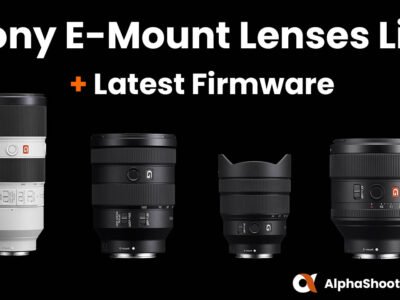
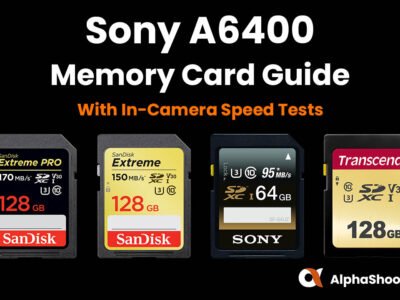
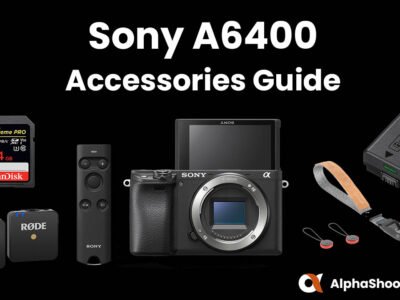
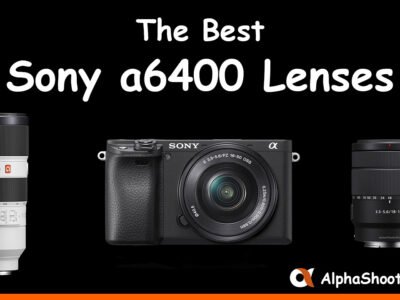
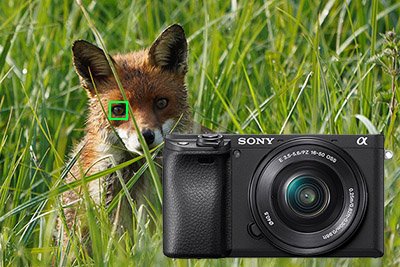
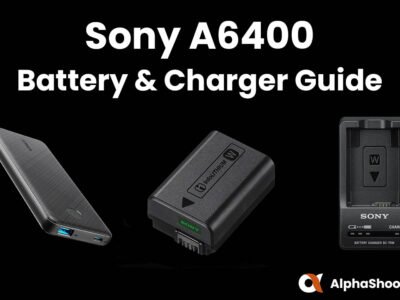
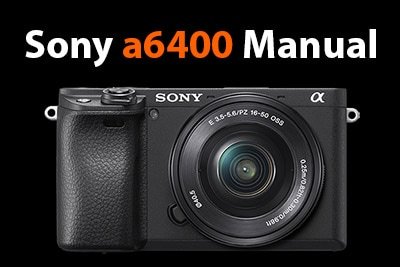
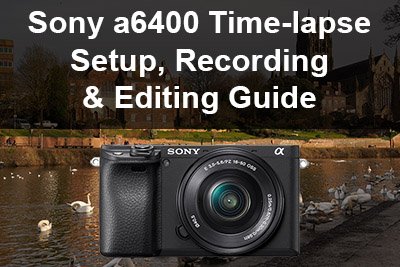

Timothy – thank you for this helpful site. I’ve had my a6400 for a couple of years and this information has been by far the best. I do have a question. I have the tamron 70-180 that I use for Volleyball. I don’t sit far from the girls and still struggle with the focusing as I’m moving my camera from girl to girl. I’m thinking about purchasing a 50mm f1.8 in hopes focus will be better and everything is within reach (not requiring me to zoom in/out) I understand this will give me 75 mm which I think will help me achieve what I need and if I want to zoom out I can just stand and walk back a bit. Unless you think I need a 35mm f1.8 which will give me 52.5 but I don’t want to get the entire court just the girl I’m targeting with maybe a bit of court. Unless 35mm will help achieve it all and All I have to do is while editing crop what I need with out taking away from the quality of my picture. Also I read your recommendation for everyday is 18-132 f3.5. I have this lens too. But when I shoot volleybal, which is indoors, it’s not the greatest. Unless you meant to outdoor shoots. Thanks for your help.
You need to update this page with 2 new Tamron lenses:
Tamron 11-20 F2.8 – According to the reviews it’s much better than Sony 10-18 except the stabilization.
Tamron 17-70 F2.8 with stabilization – Great lens which is a rival to the Sony 16-55 F2.8 which is without stabilization.
Thanks for pointing these out Gilad. You are right, this guide is in need of an update. Will work on getting that done!
Hii.. I’ve sony6400. Am a wedding photographer (beginner) am planning buy a cine lens for my camera for videos ..samayang 135mm manual lens or meike 25mm manual is good for 6400 which is better or suggest me something
Hi Tim,
I have Somy 6400 with kit lens Somy 16-50 and Sony 18-105. I review flights and often come across low light and need to shoot videos at a close range like shooting the food (on tray table) or seat or inflight features or a crammed lavatory 🙂
Which lens do you recommend for this?
I did observe that when I tried using 18-105, I was not able to keep sharp focus on close objects and it continued to blur every now and then. Pls advise.
Hi,
I usually love to take pictures of views, particularly mountains and lakes. With the current lens i have, i cannot capture the whole view, only a little part. What is the best lens to buy for Sony A6400 to capture a very wide range?
Hi Nessa. You’ll want a lens with a wider focal length to get more in the shot, something like the Sony E 10-18. But there are quite a few other options too. What focal length is the lens that you are currently using? And what’s your budget for a new lens?
Hello, I recently purchased the a6400, along with the E 18-135mm F3.5-5.6 OSS and I am pretty much a novice shooter. I have three active kids that play soccer, track and gymnastics (low light activity) and I was so frustrated with the picture and video quality that i get from my cell phone, that i finally decided to buy a real camera. I primarily plan to use the a6400 for video and i noticed the E 18-135mm F3.5-5.6 OSS just doesn’t provide enough zoom. So I am about to buy the Sony E 70-350mm F4.5-6.3 G OSS for more zoom. Please tell me if this is the best zoom lens for novice users and also for primarily taking video. Also, it’s been ages since i bought a camera and I was expecting a “how to” manual to become familiarized with all of the features, but the days of a printed manual are long gone. Can you suggest a place or resource that I can go to to learn how to use this camera, so I don’t keep it in auto mode?
Hi Nia. Sorry for the slow reply. Did you purchase the E 70-350 in the end? This would be my choice for shooting sports with the Sony a6400, providing you have pretty good light available. Mark Galer has a lot of good videos available along with an eBook, these should really help you to learn the ins and outs of this camera.
Love your review Timothy
especially in portraits section instead of human you replace with dog. respect
I am into Fashion photography and mainly portraits and product shoot.
what would you reccom?
18-135?
18-105?
or 30 sigma?
Sorry for the slow reply Bandi. For portraits I’d really recommend a fast prime over a zoom lens like the 18-135. So perhaps something like the Sigma 56mm F 1.4.
Hello Timothy,
Very nice and useful article! Thank you so much for providing the information. I am new to the professional photography and also Sony A6400 (Bought last week). I purchased the kit lens that comes with Sony (PZ 16-55mm & E55-210mm). After shooting few pics, I am not seeing a great image quality & sharpness. Do you think I should replace these two lenses with either E 18-135mm F3.5-5.6 OSS (SEL18135) or E PZ 18-105mm F4 G OSS to get a much better output? My requirements are portrait, landscape and candid photography. I live very close to the nature and mountains. So I am looking for something that covers most of these use cases in general. Your thoughts will be appreciated.
Hi Darshan. The 18-135 is a sharper lens than the 16-55 and 55-210. It also has a very useful focal range, a short minimum focussing distance and is pretty compact. I’d only recommend going with the 18-105 if you shoot more video.
which is best for video Sony 50mm F 1.8 OSS or Sigma 56mm F 1.4?
Hi Jose, I think have already replied to you somewhere else but I can’t remember where so I’ll reply again 🙂 If you are not using a gimbal then I’d go with the Sony because of the OSS, but if you are using a gimbal then the Sigma would be my first choice. Arthur R has done a great comparison here. All the best, Tim
The three Zeiss Touit lenses made specifically for Sony APS-C seem to be missing from the list. I have the https://www.zeiss.com/consumer-products/int/photography/touit/touit-2850m.html for my a6400.
Or are they not good enough for a “best” list?
Hi Ian, I overlooked the Zeiss Touit lenses but they do certainly belong among the best lenses out there so I’ll get them added to the article. Thanks!
I just want to really thank you for all tht hard work uv put into this article. Never seen so much coverage on one page bravo!
Thank you very much Abdullah!
I’m considering getting into the Sony system and this seems like the best introduction to the Sony lineup of lenses I’ve encountered online. Thanks for taking the time to pull it all together. I look forward to your impressions of the new 200-600mm lens vs the G-master 100-400 zoom when it comes to Sony APC wildlife work.
Thanks for your comment Bruce. I am looking forward to the 200-600 and expect that I will end up selling my 100-400 at some point soon. If you check Mark Galer’s review on YouTube then the 200-600 is sharper at 600mm than the 100-400 is with the 1.4x at 560mm, but he also said he got more keepers with the 100-400 so the af on the 200-600 is a tad slower. Personally I can never get enough reach for wildlife so the 200-600 with the option of adding the teleconverters will probably be my preferred choice going forward. I think the internal zoom will also make handling it much nicer than the 100-400 despite the extra weight and length. All the best, Tim